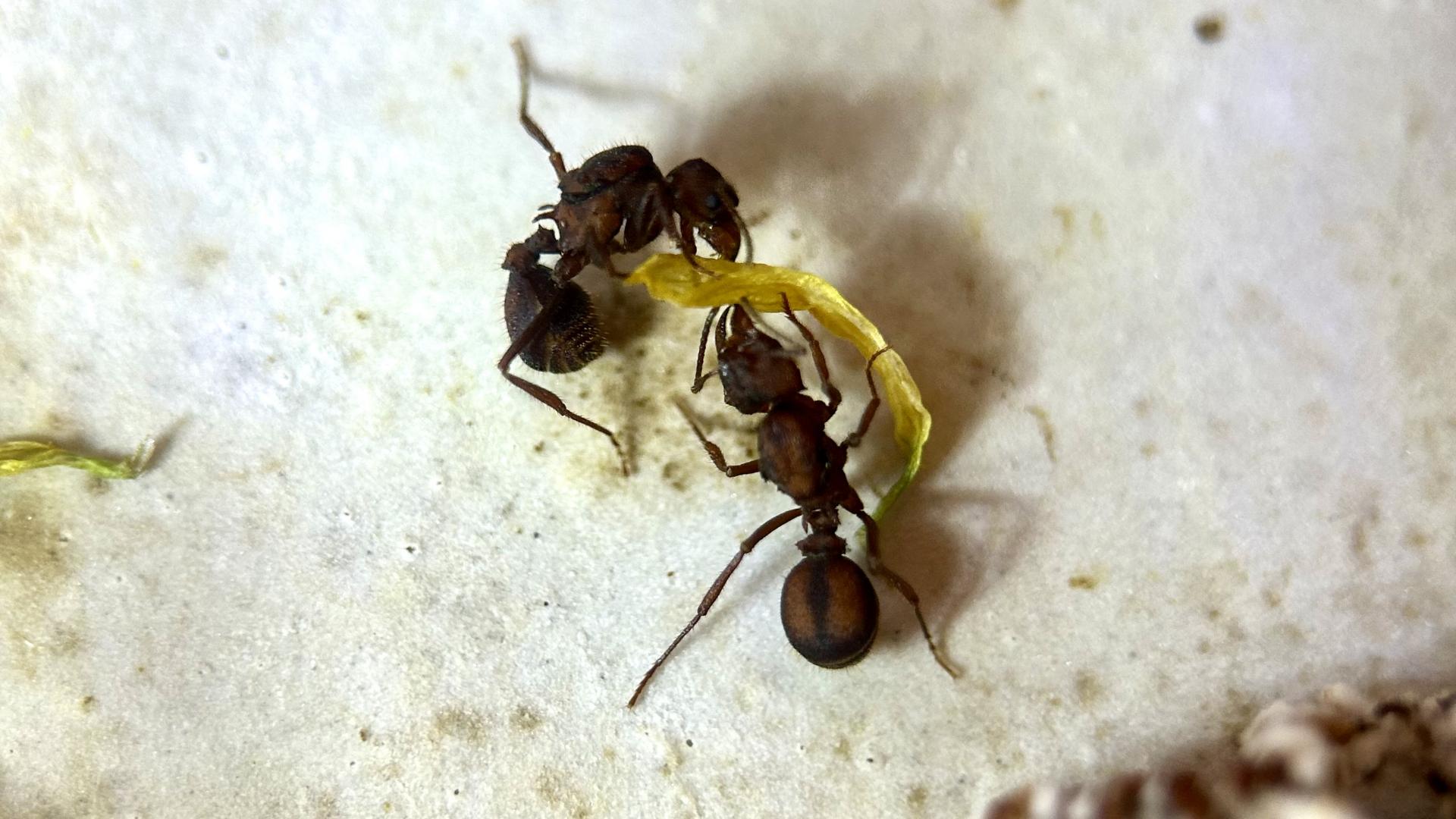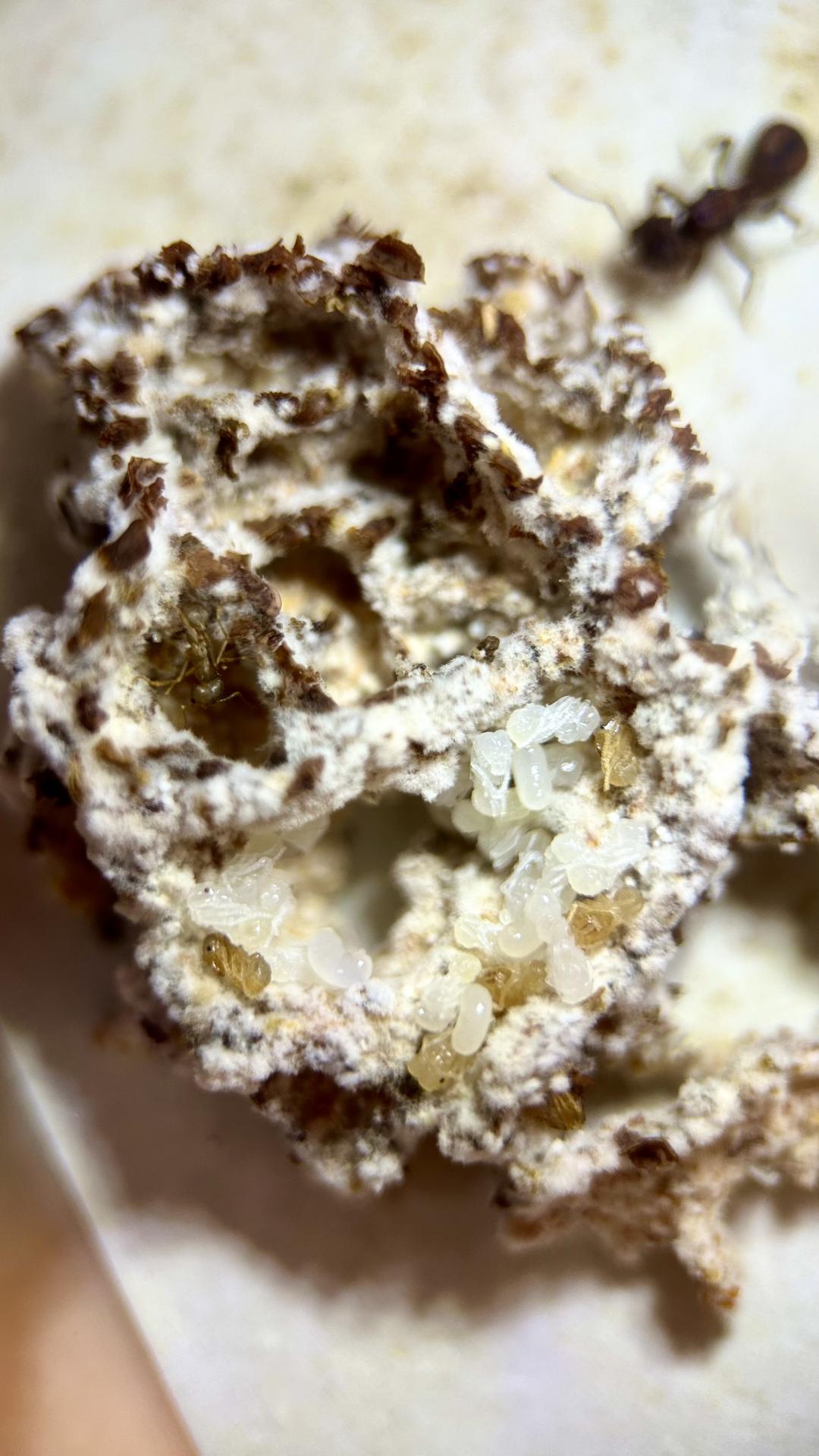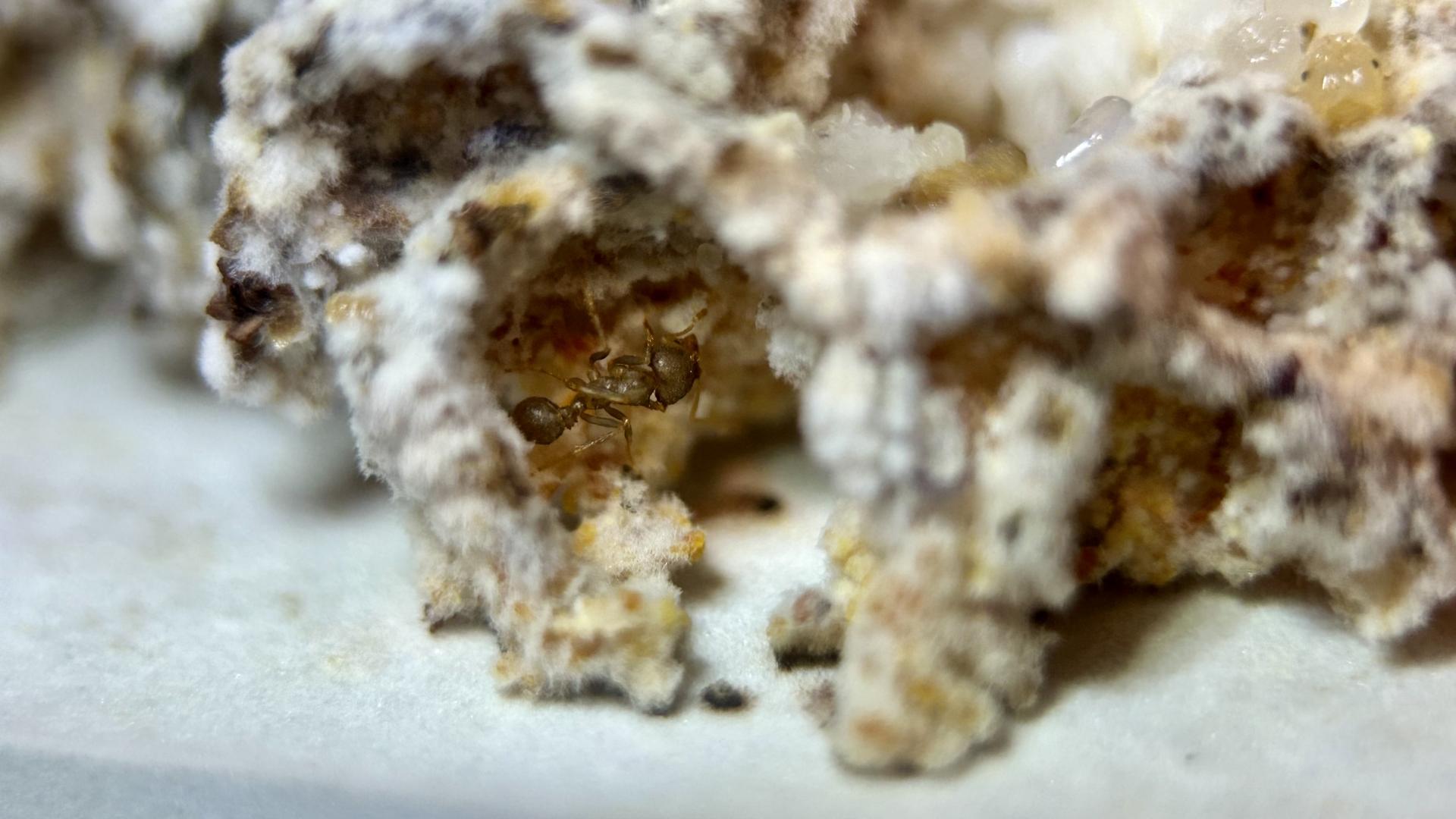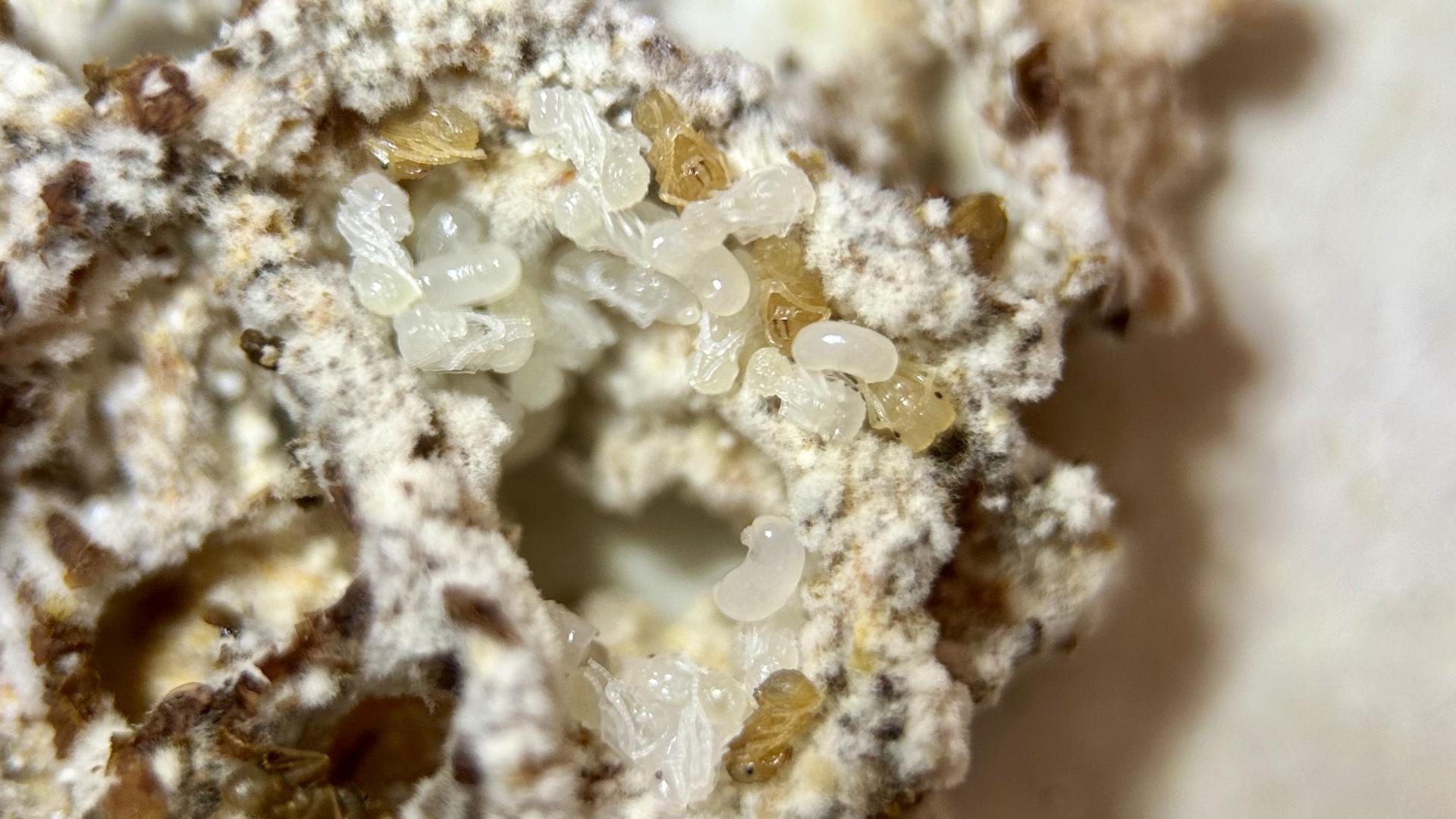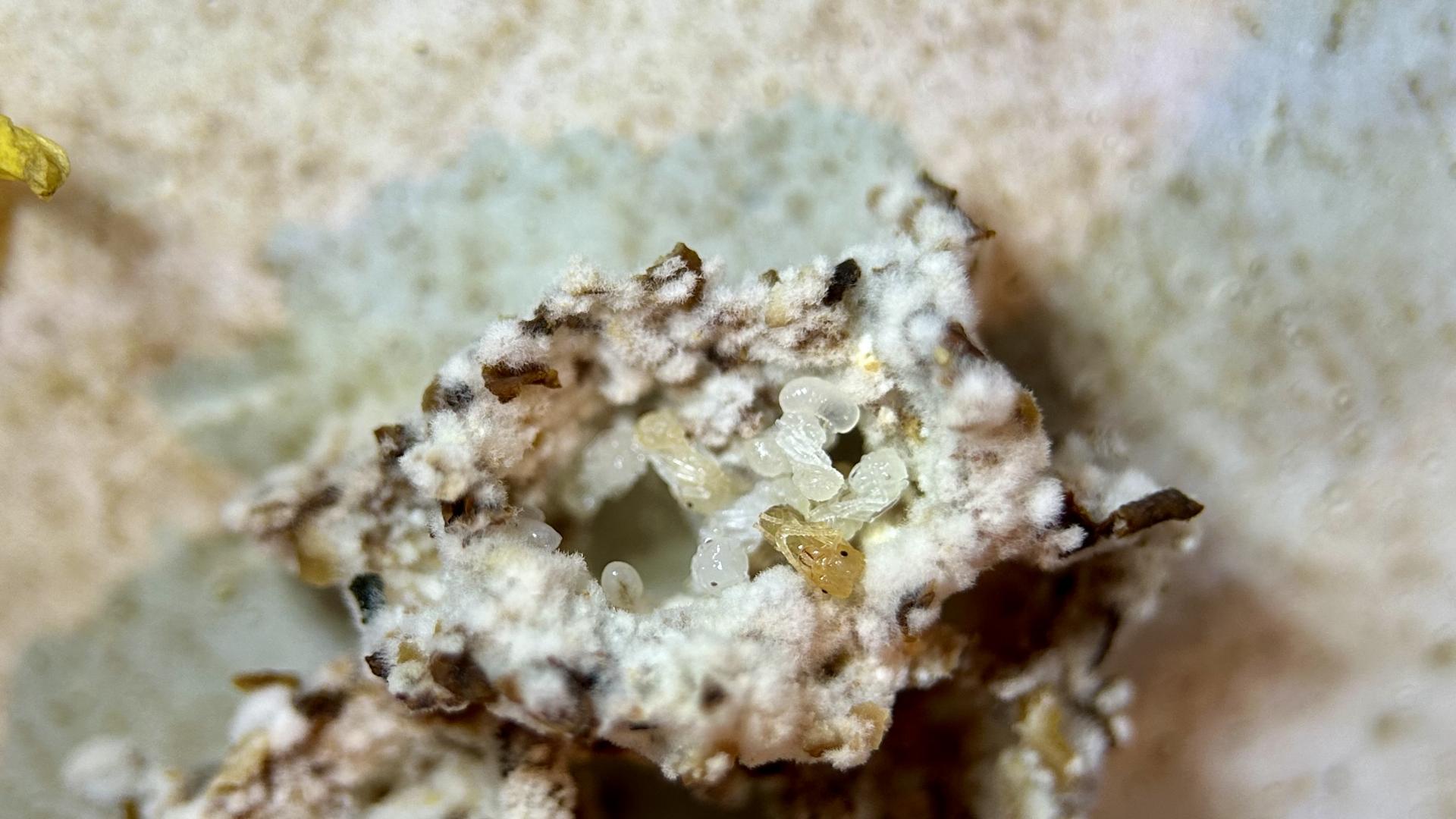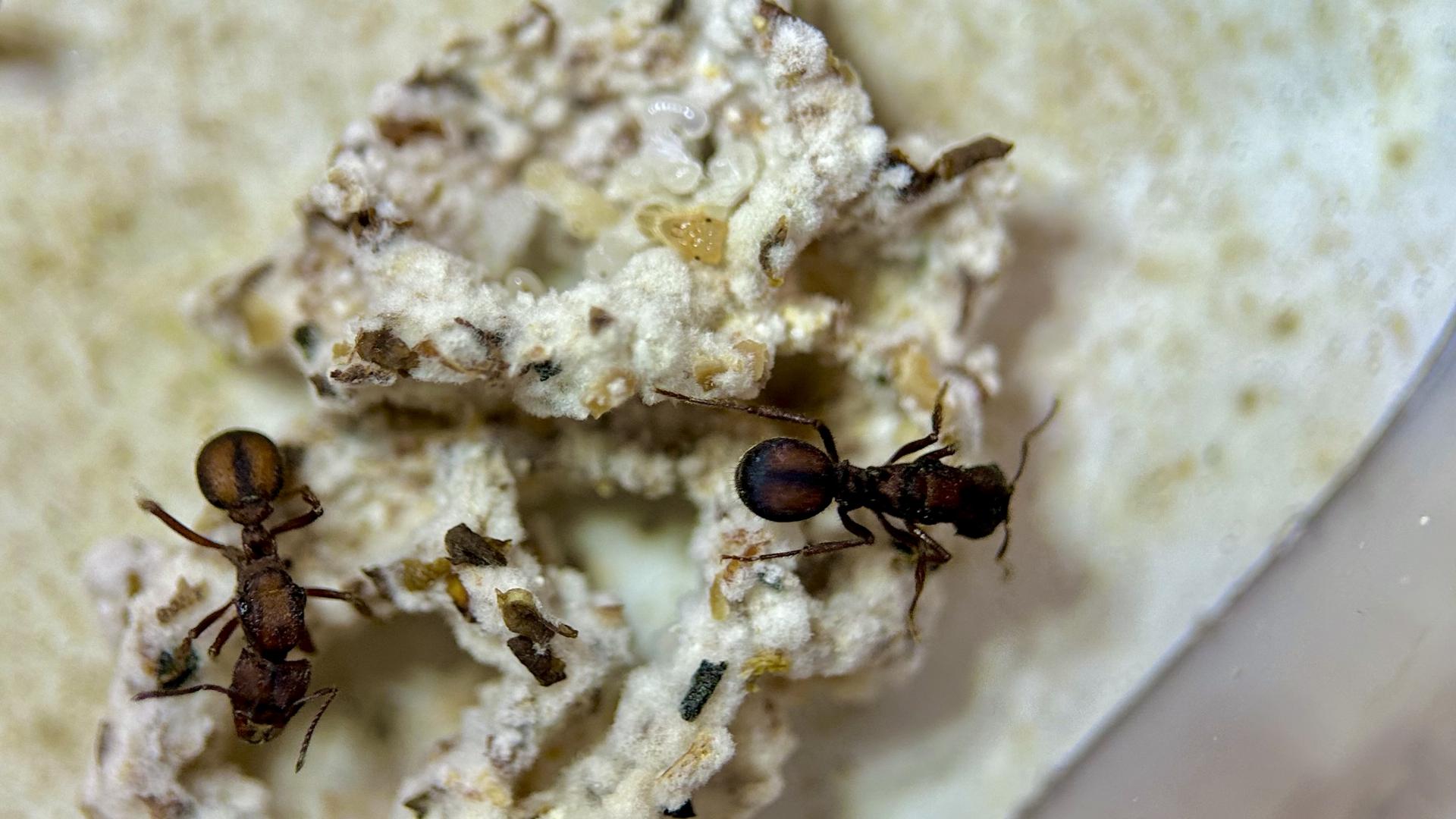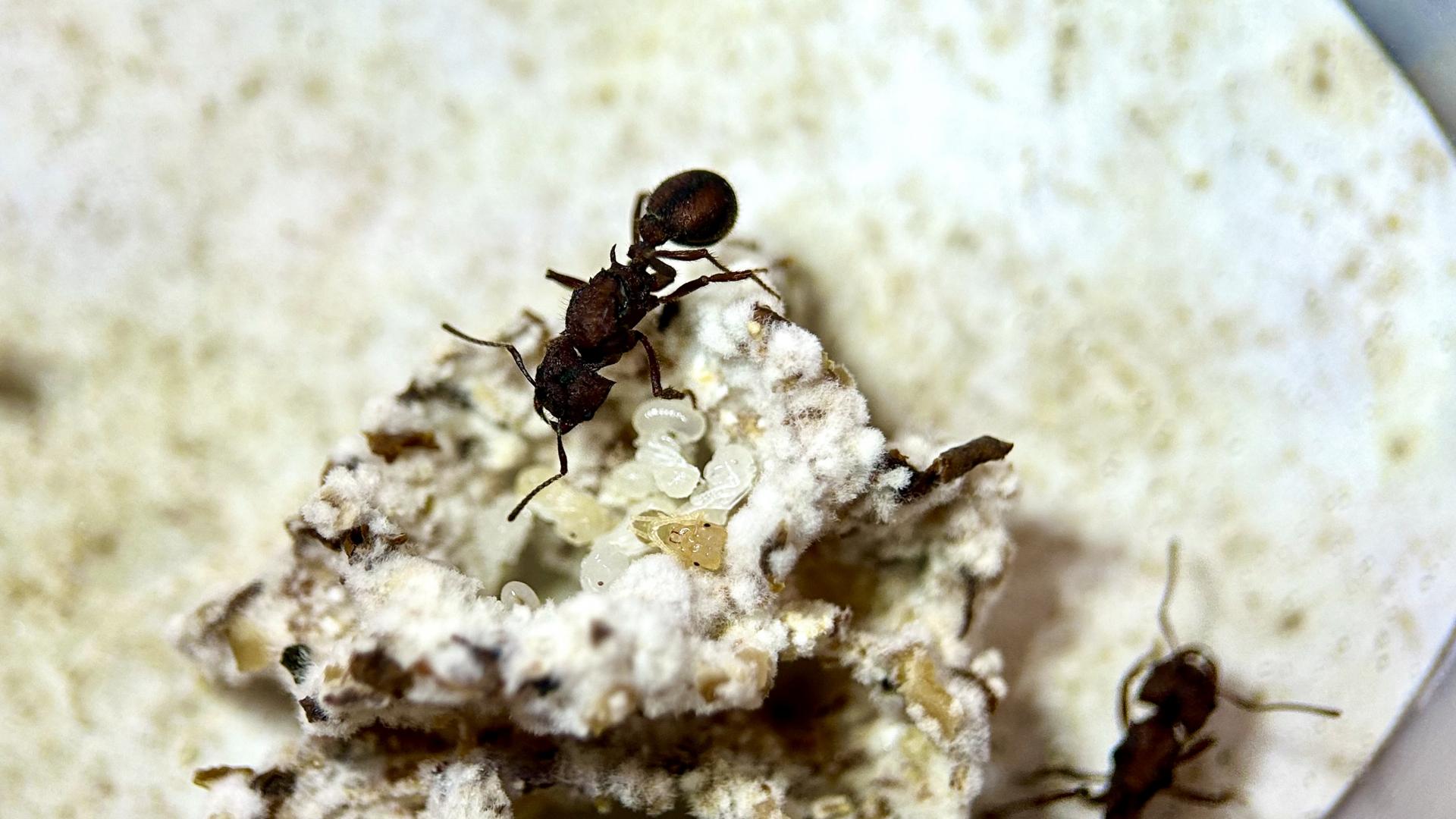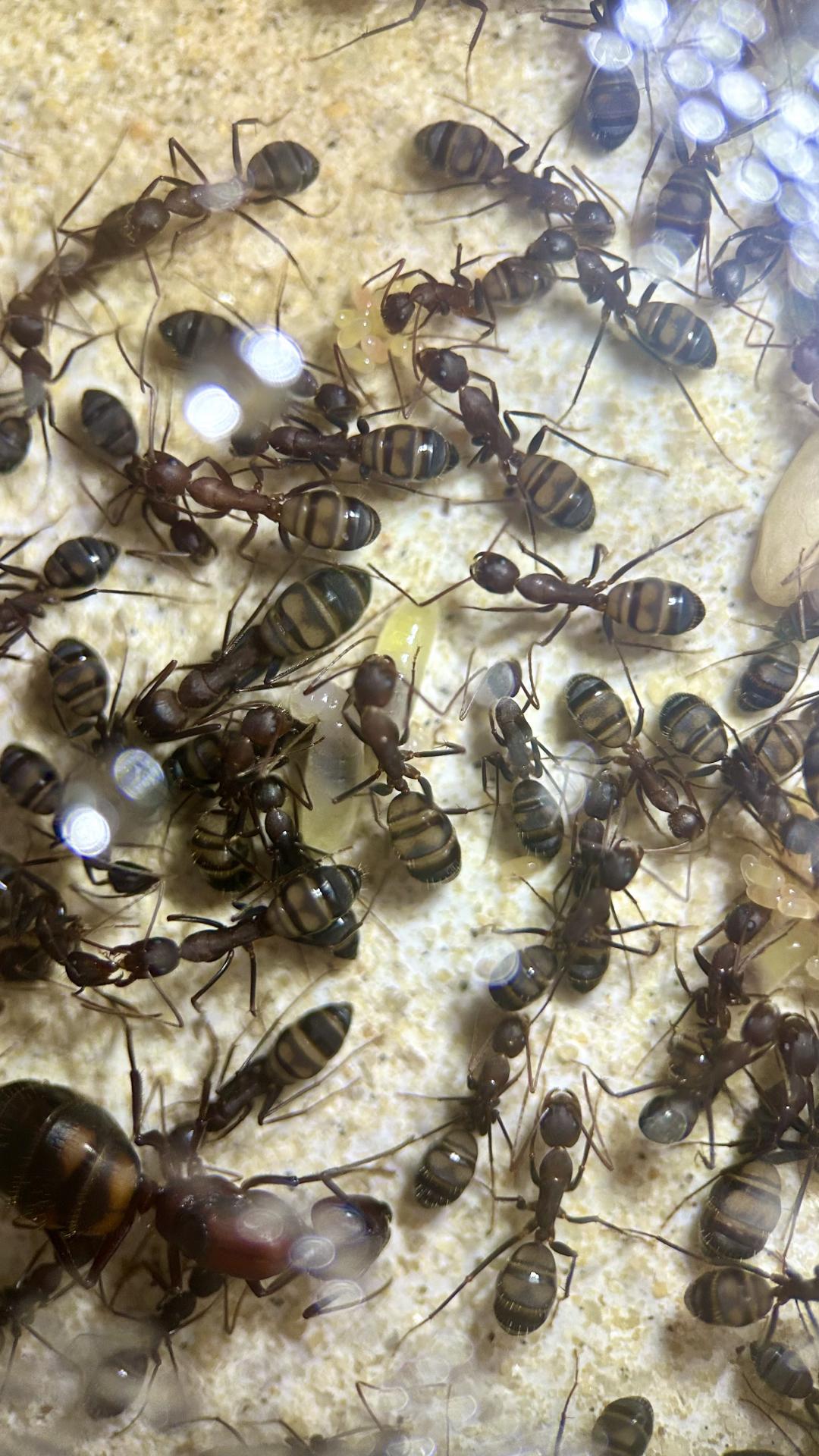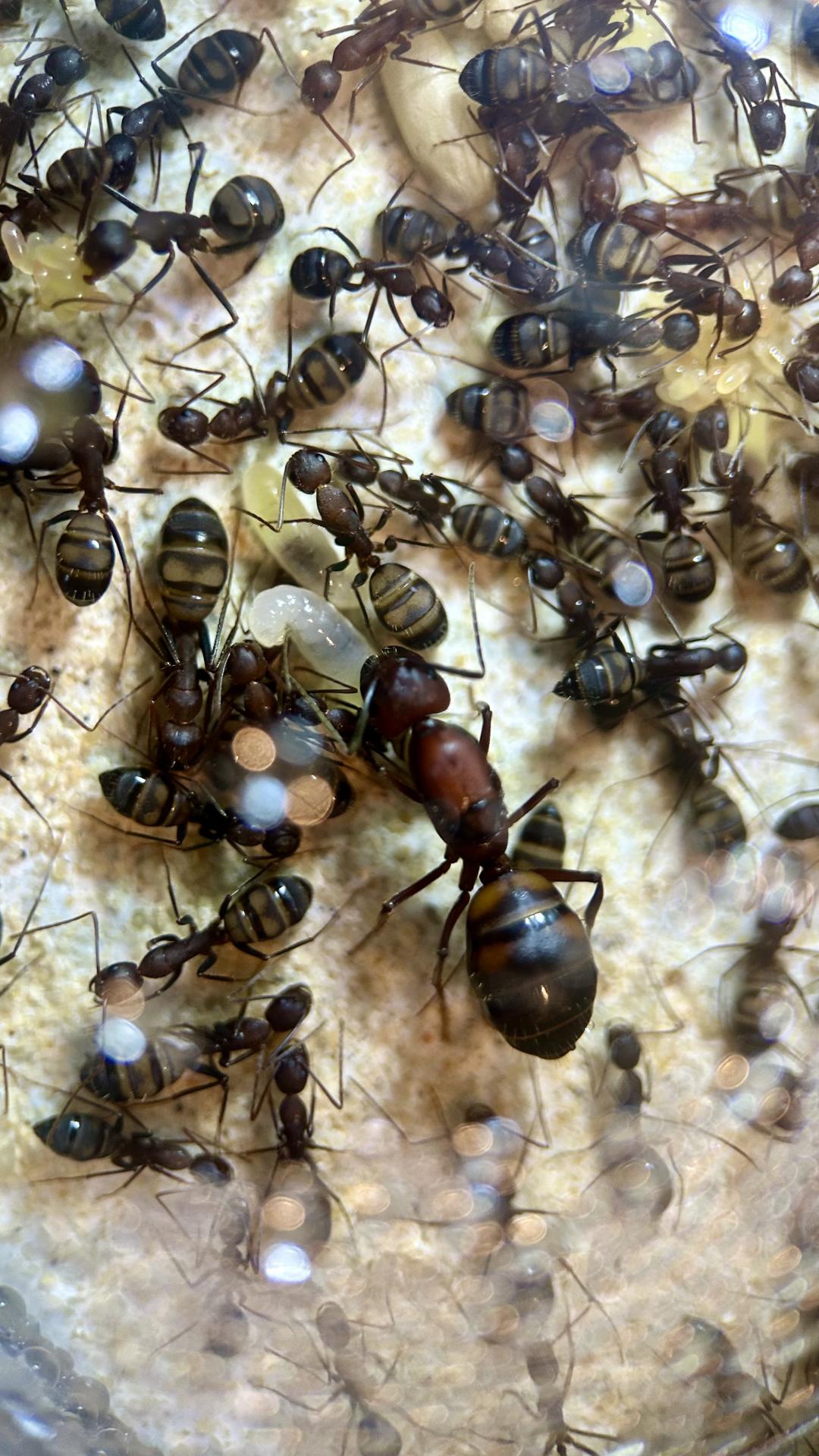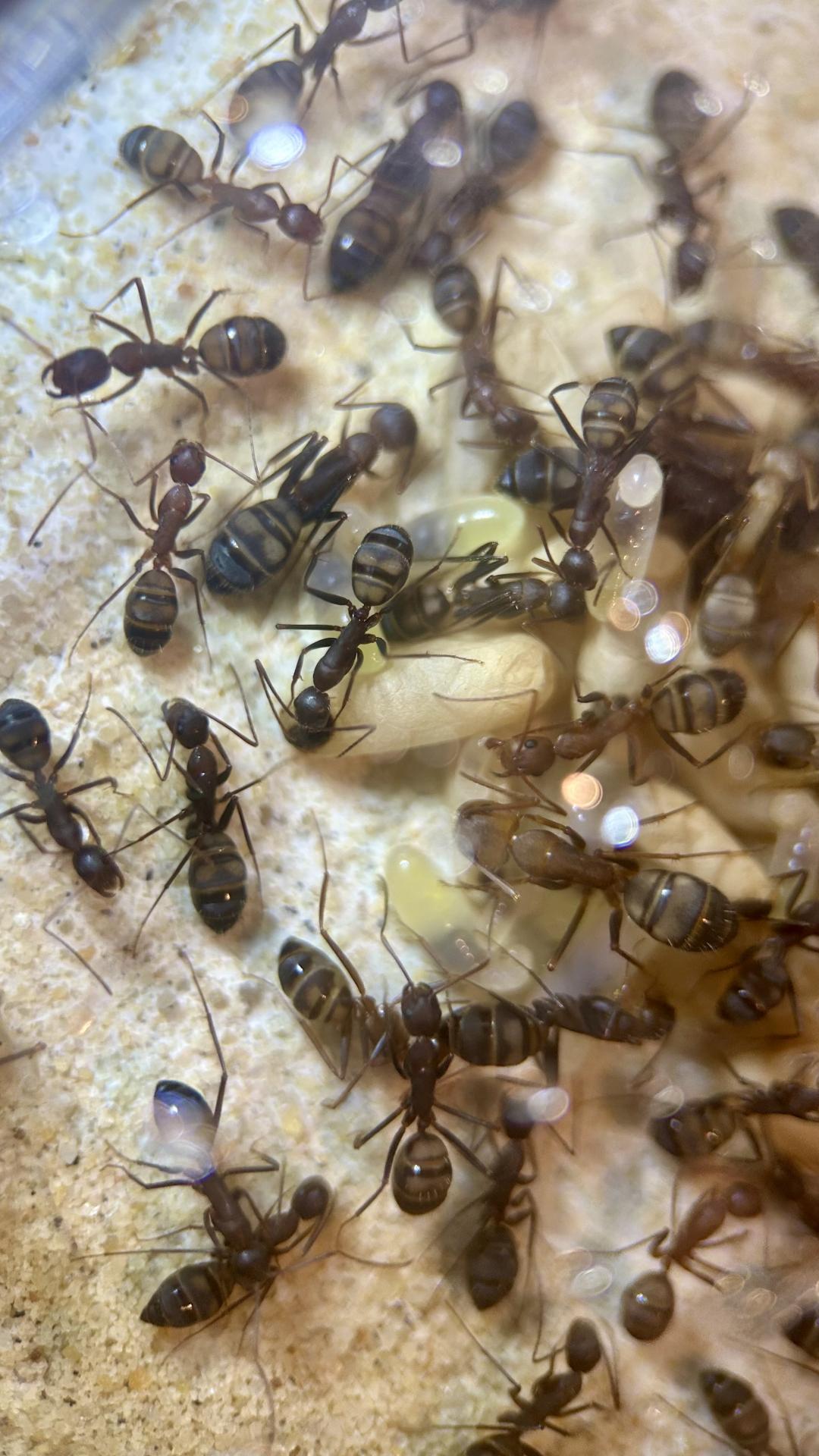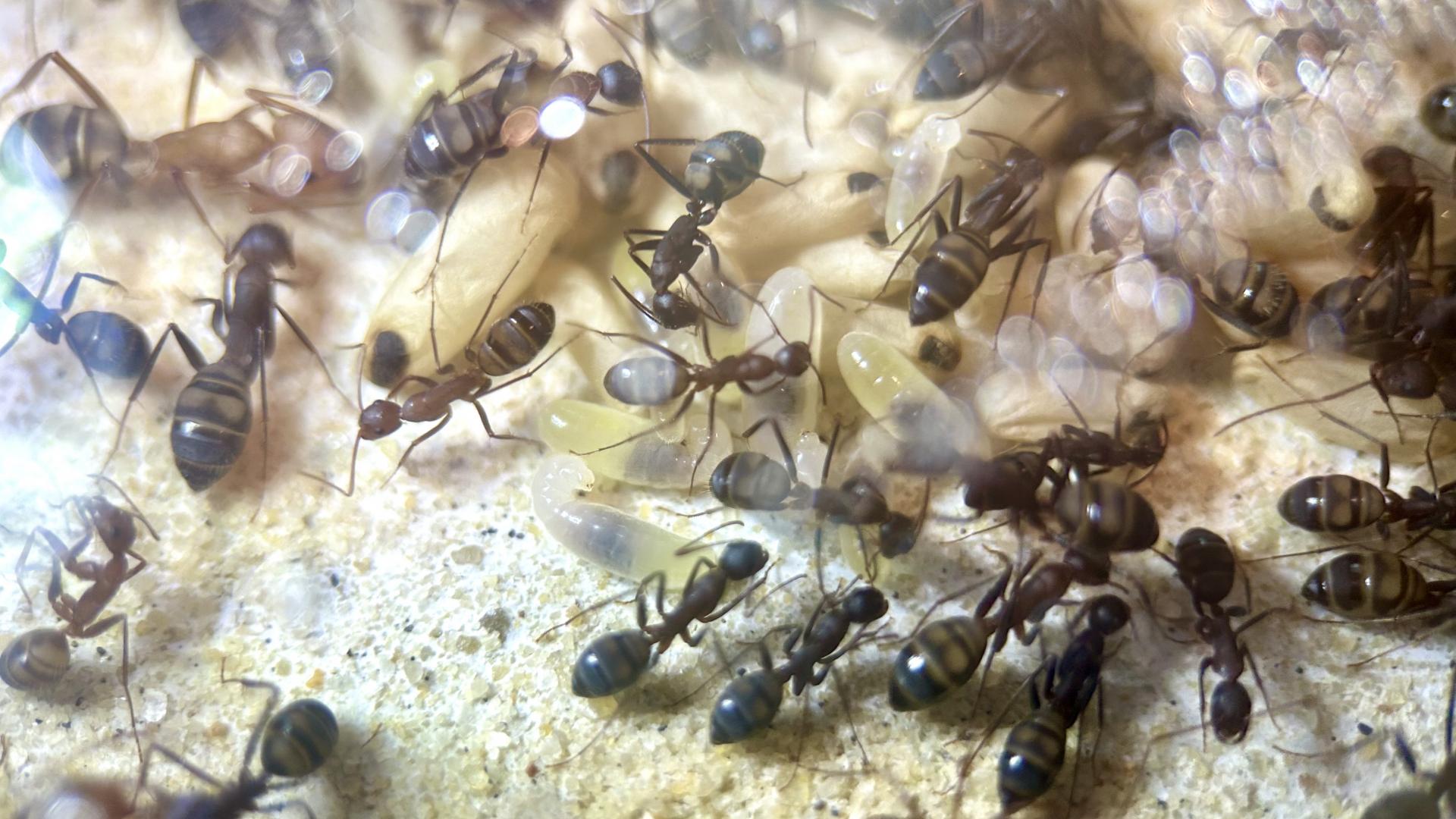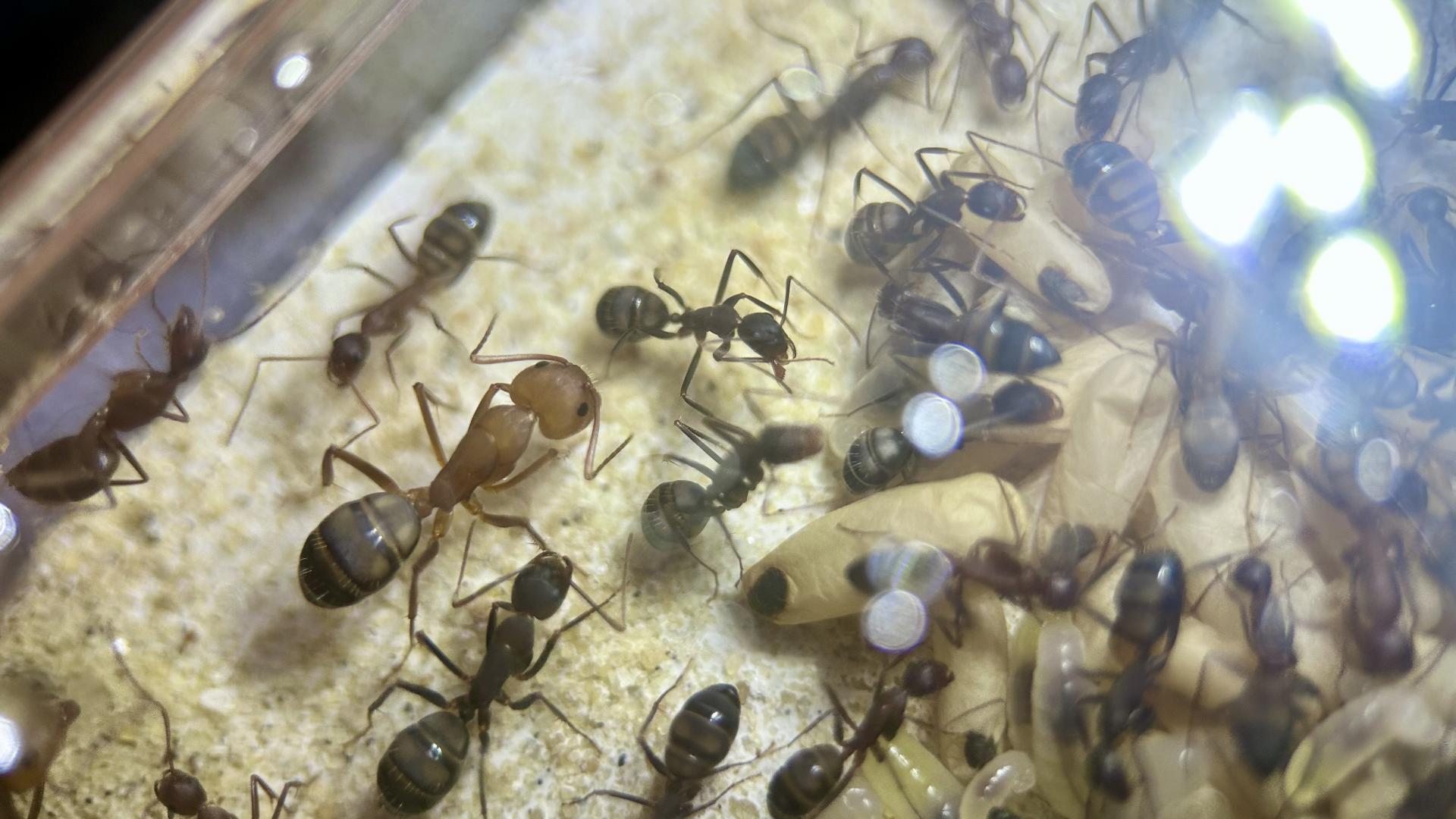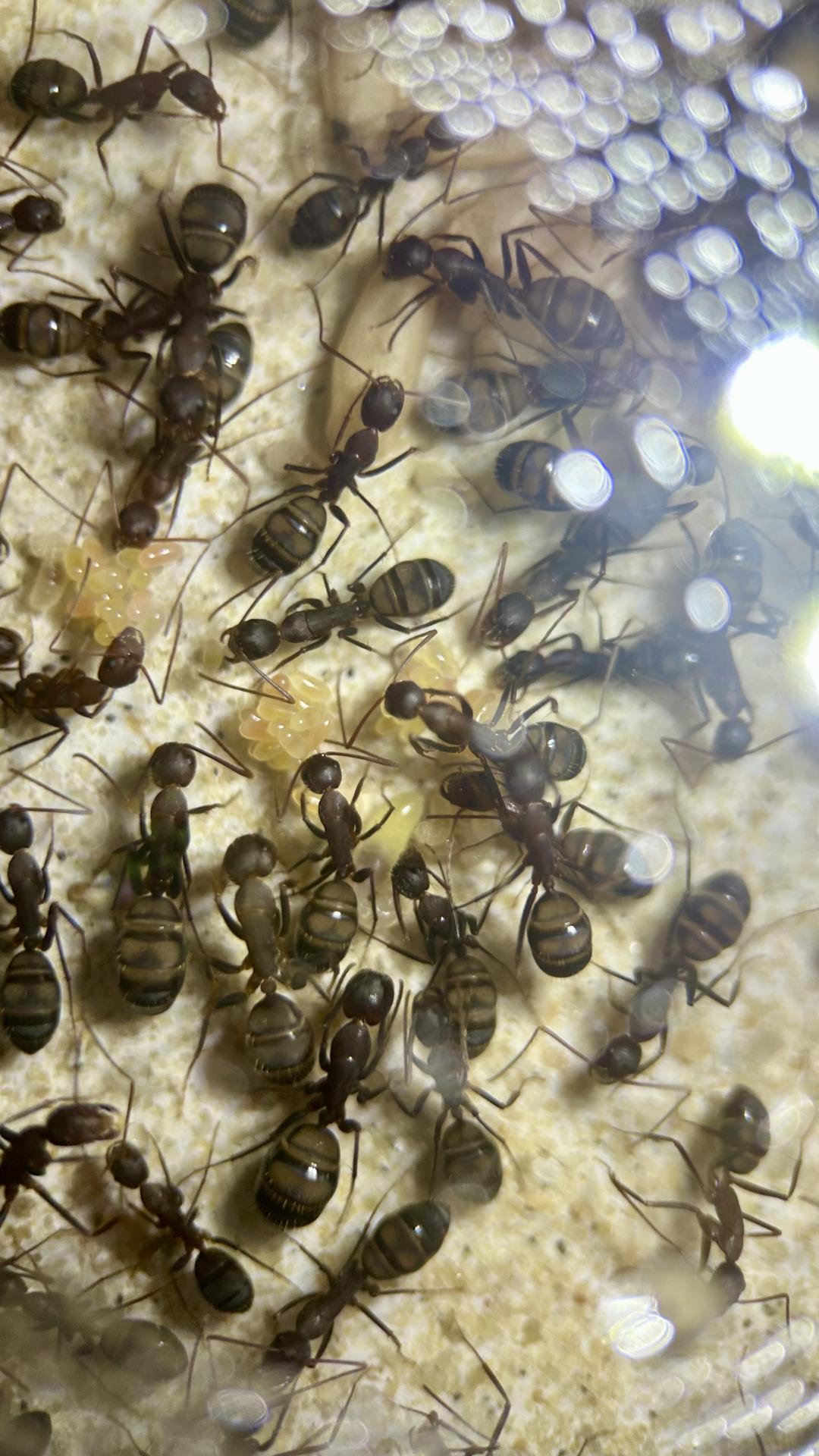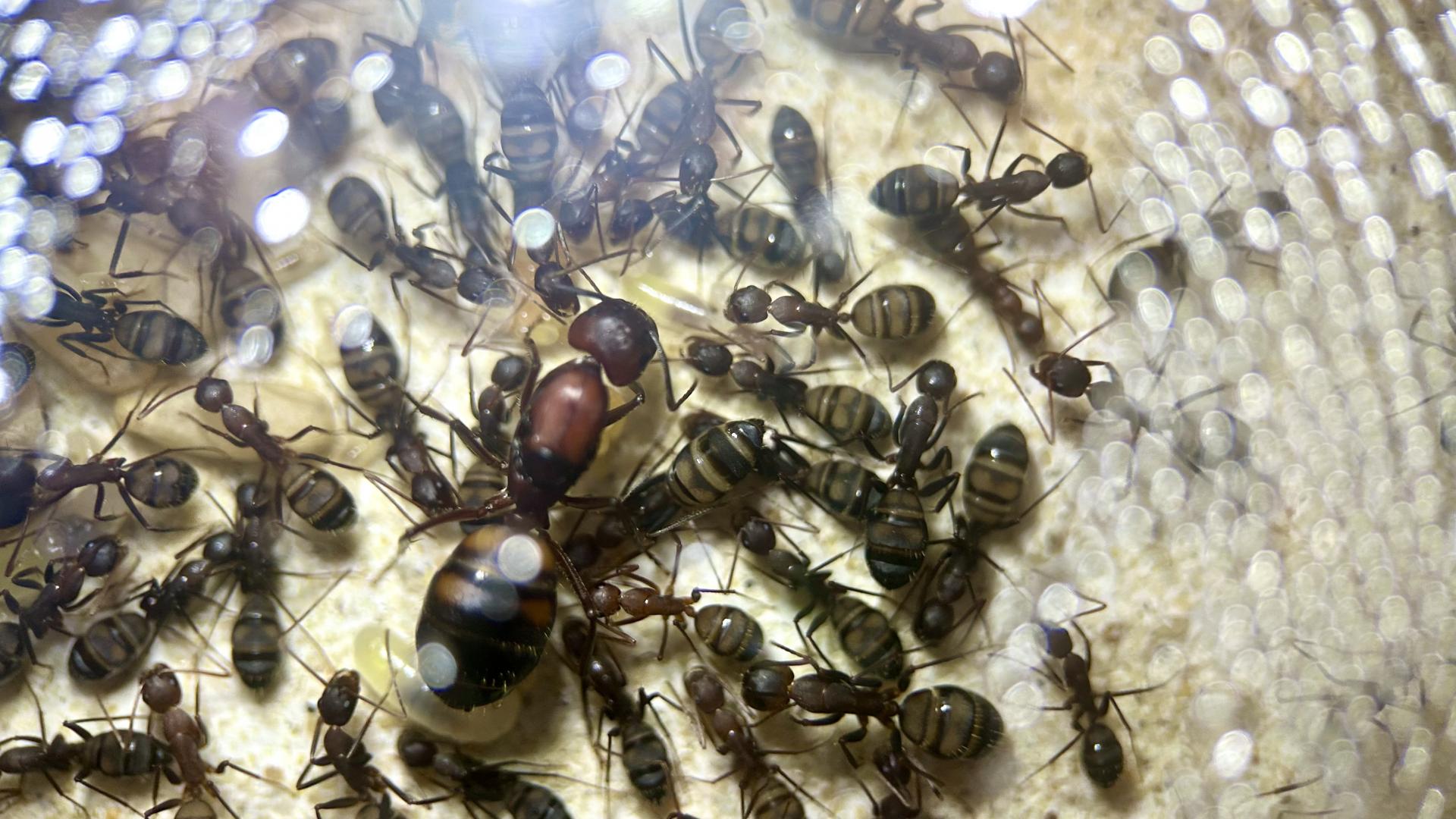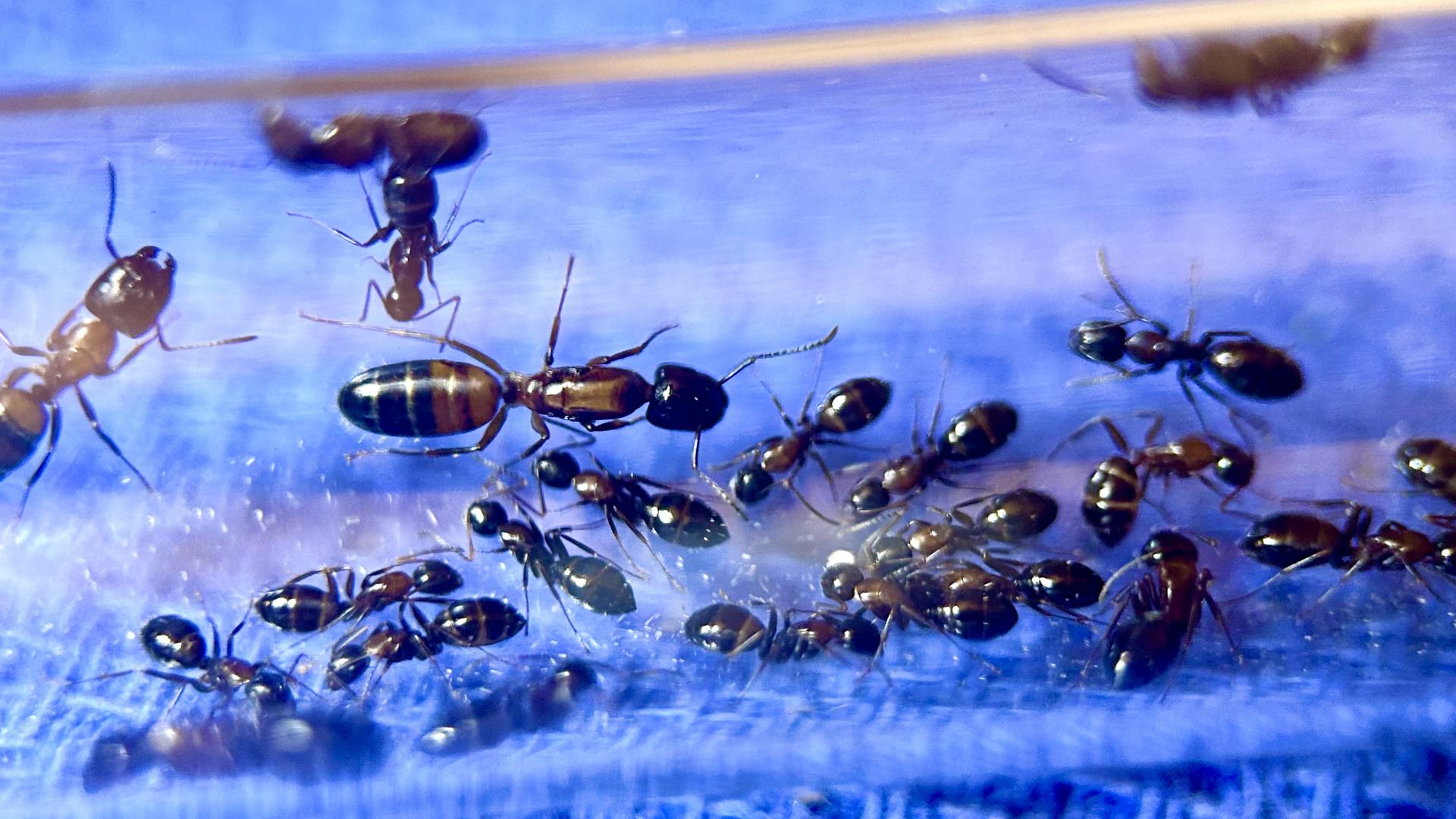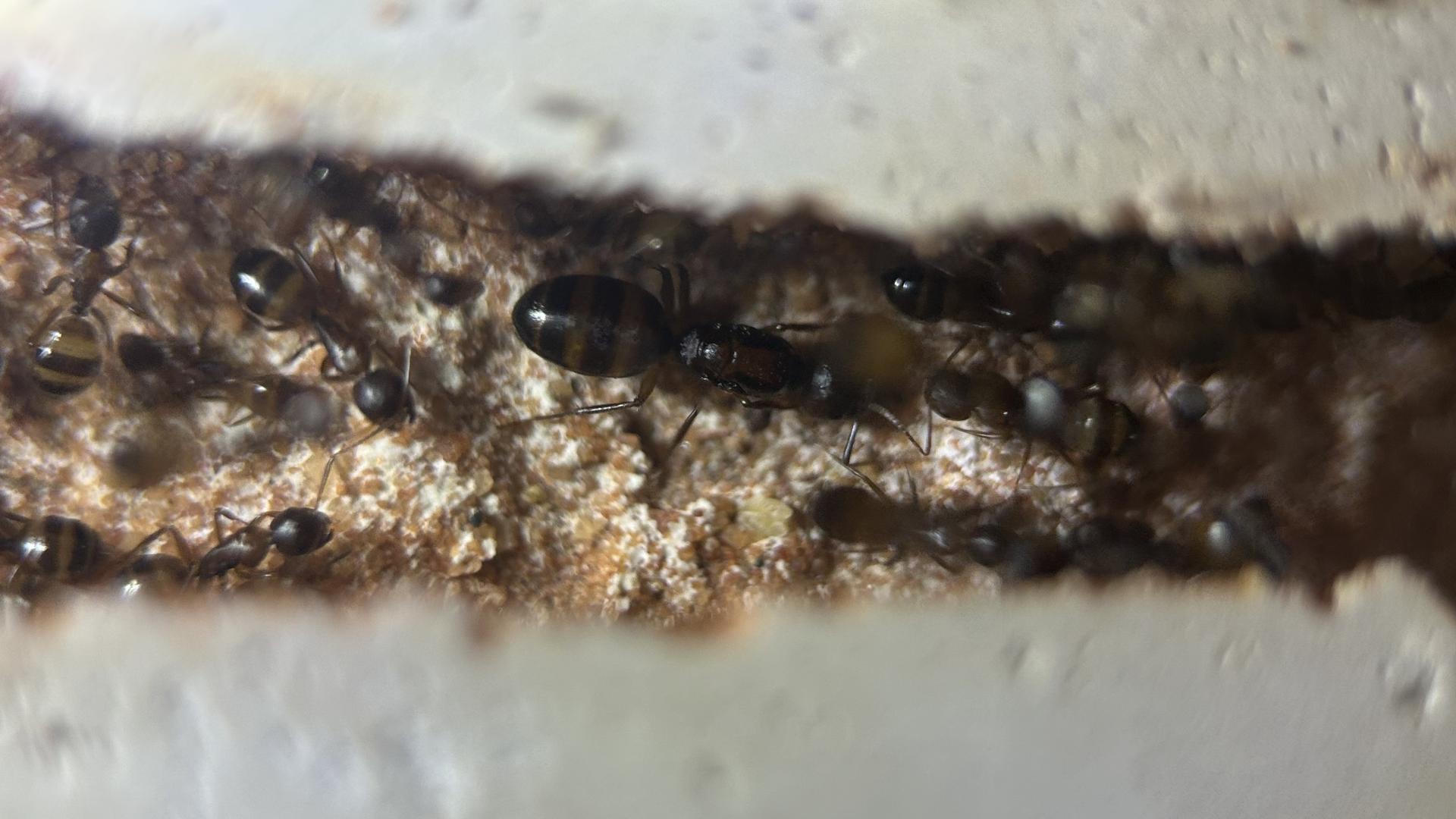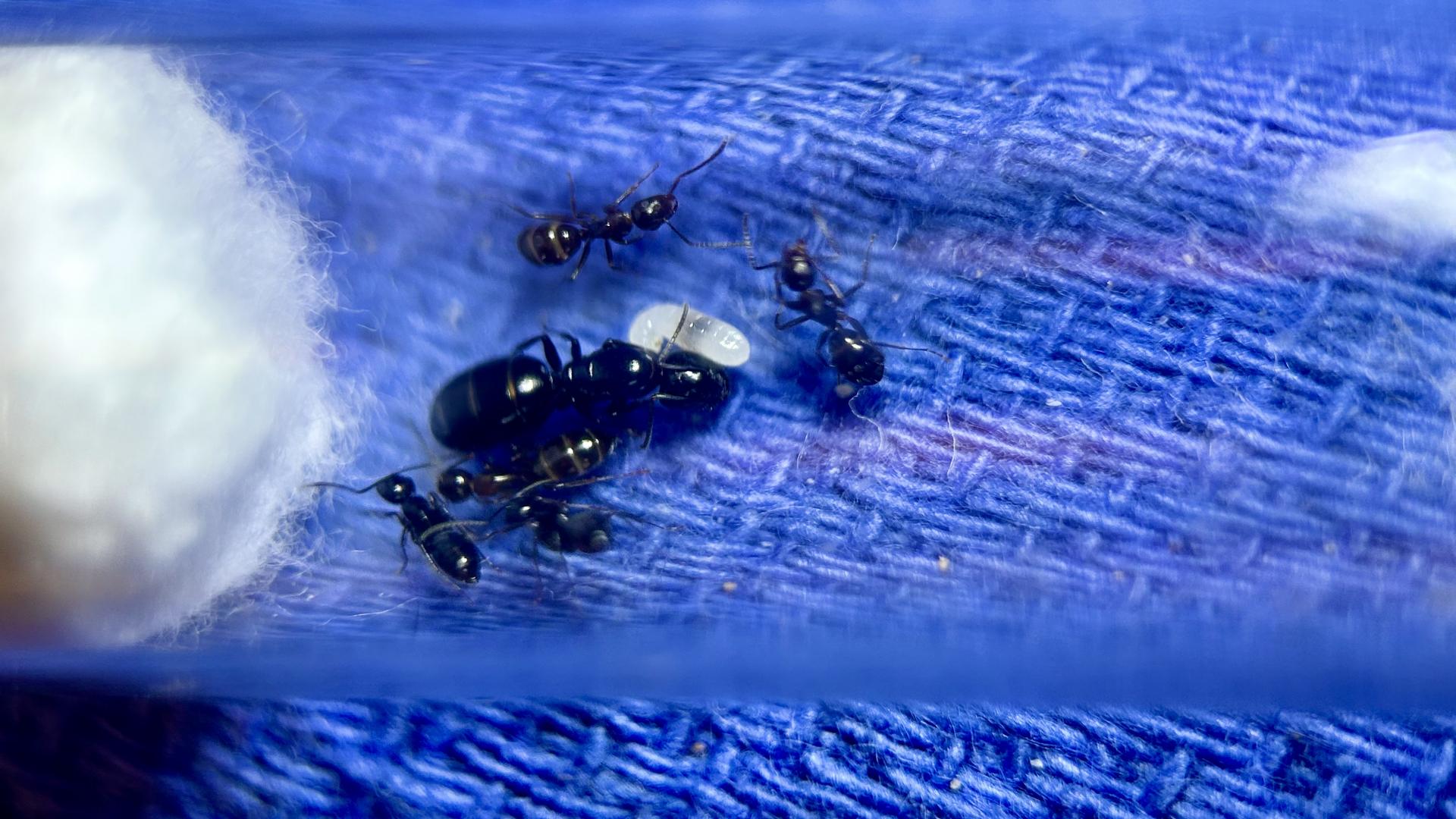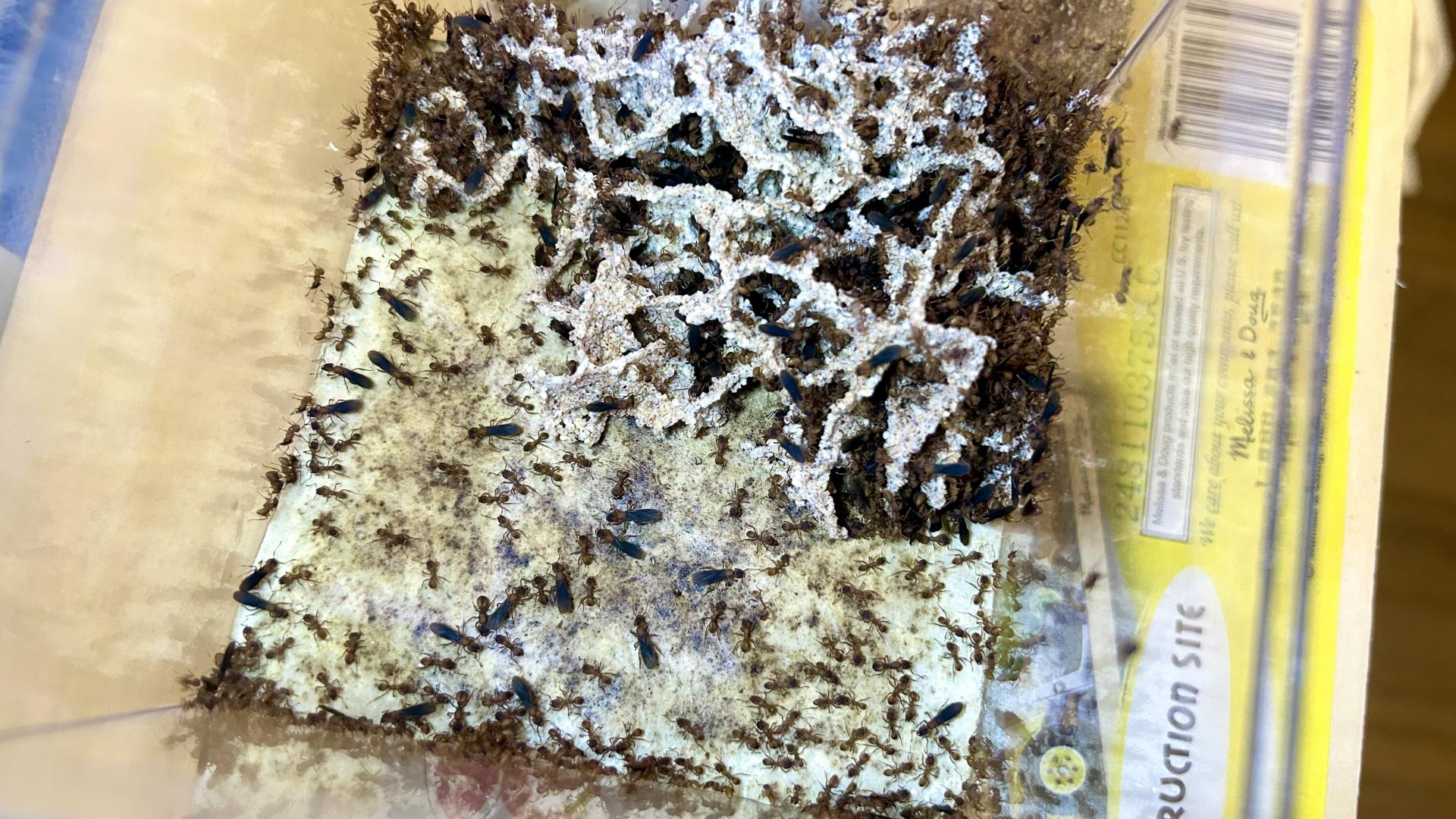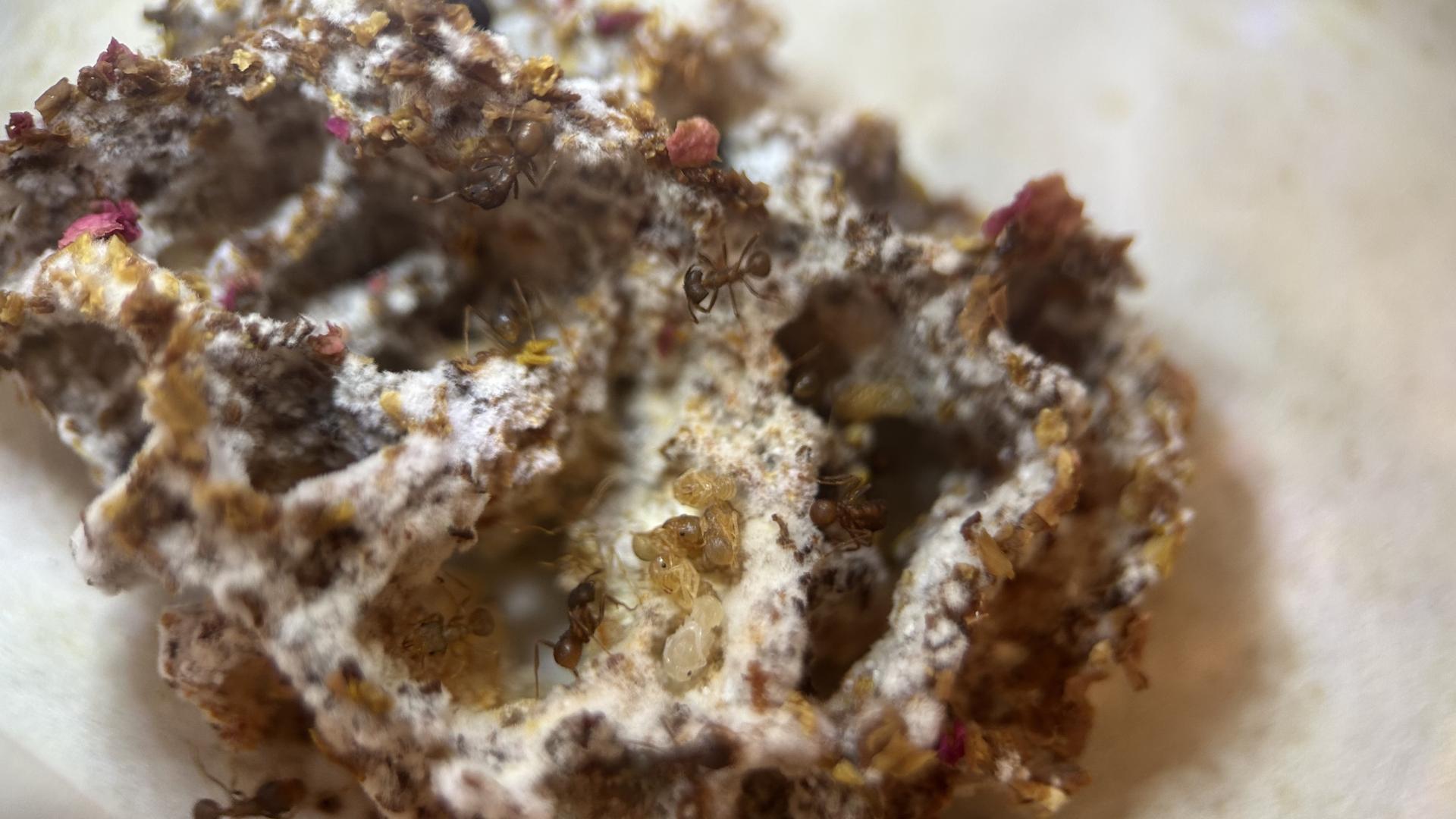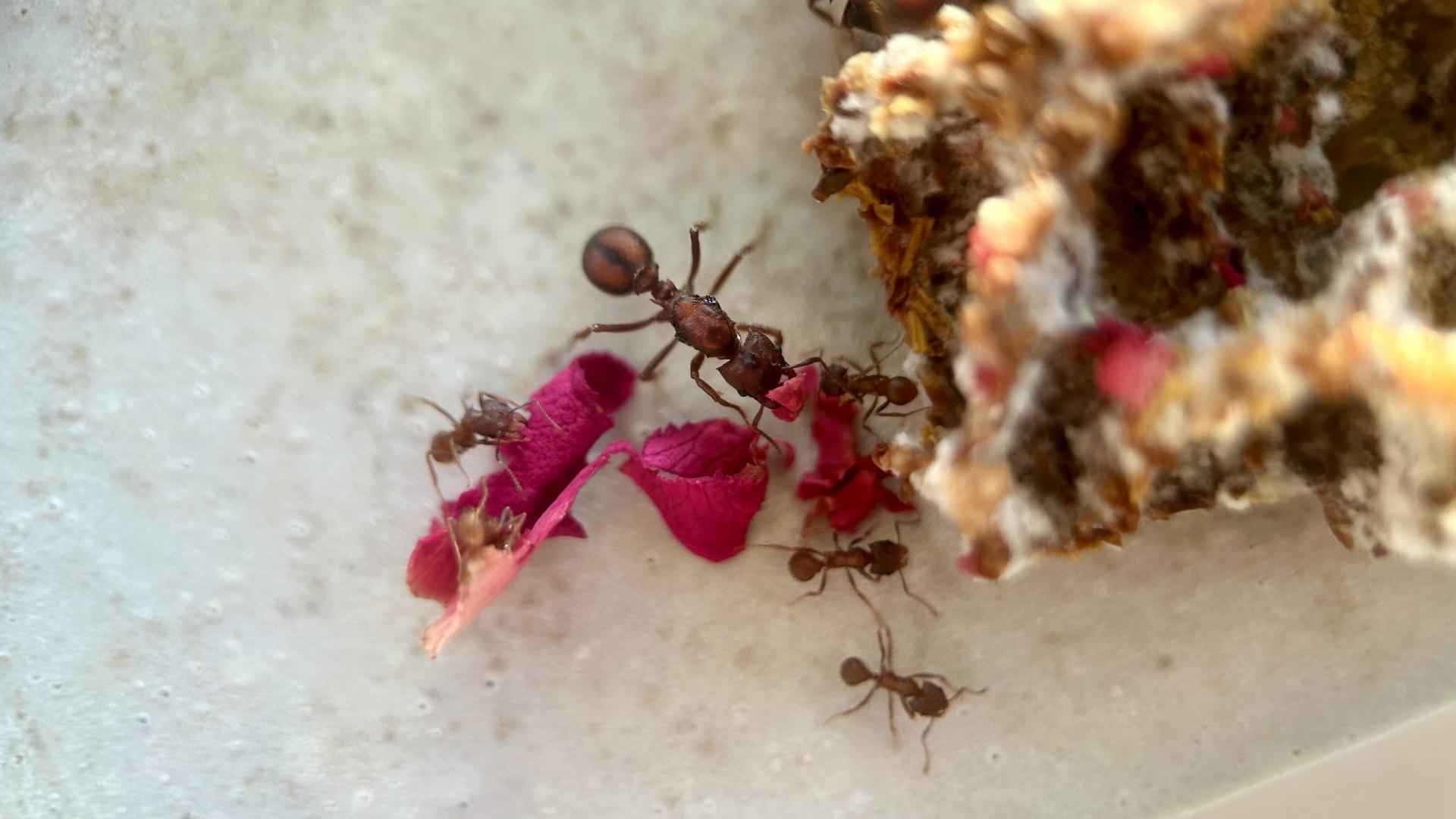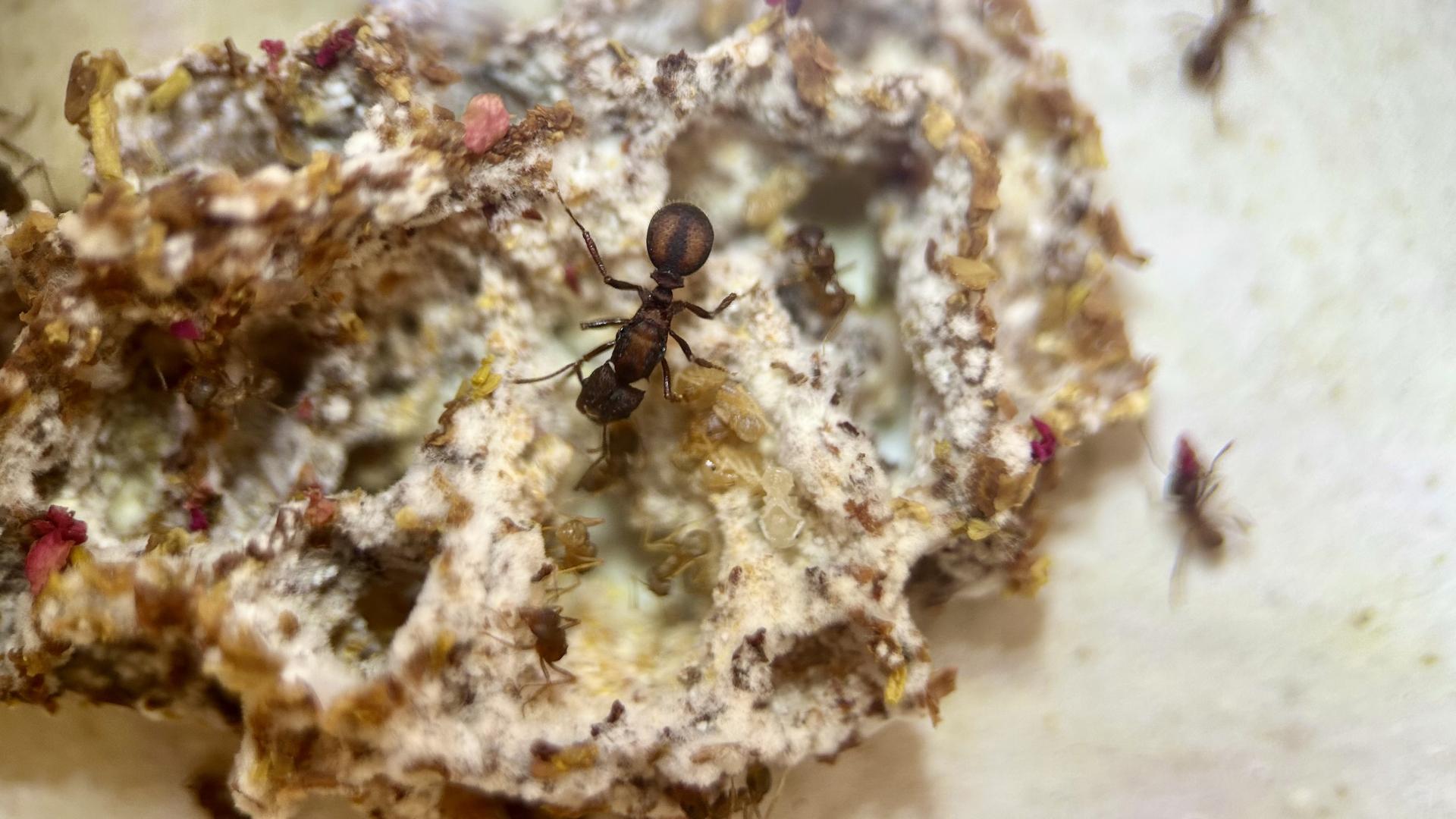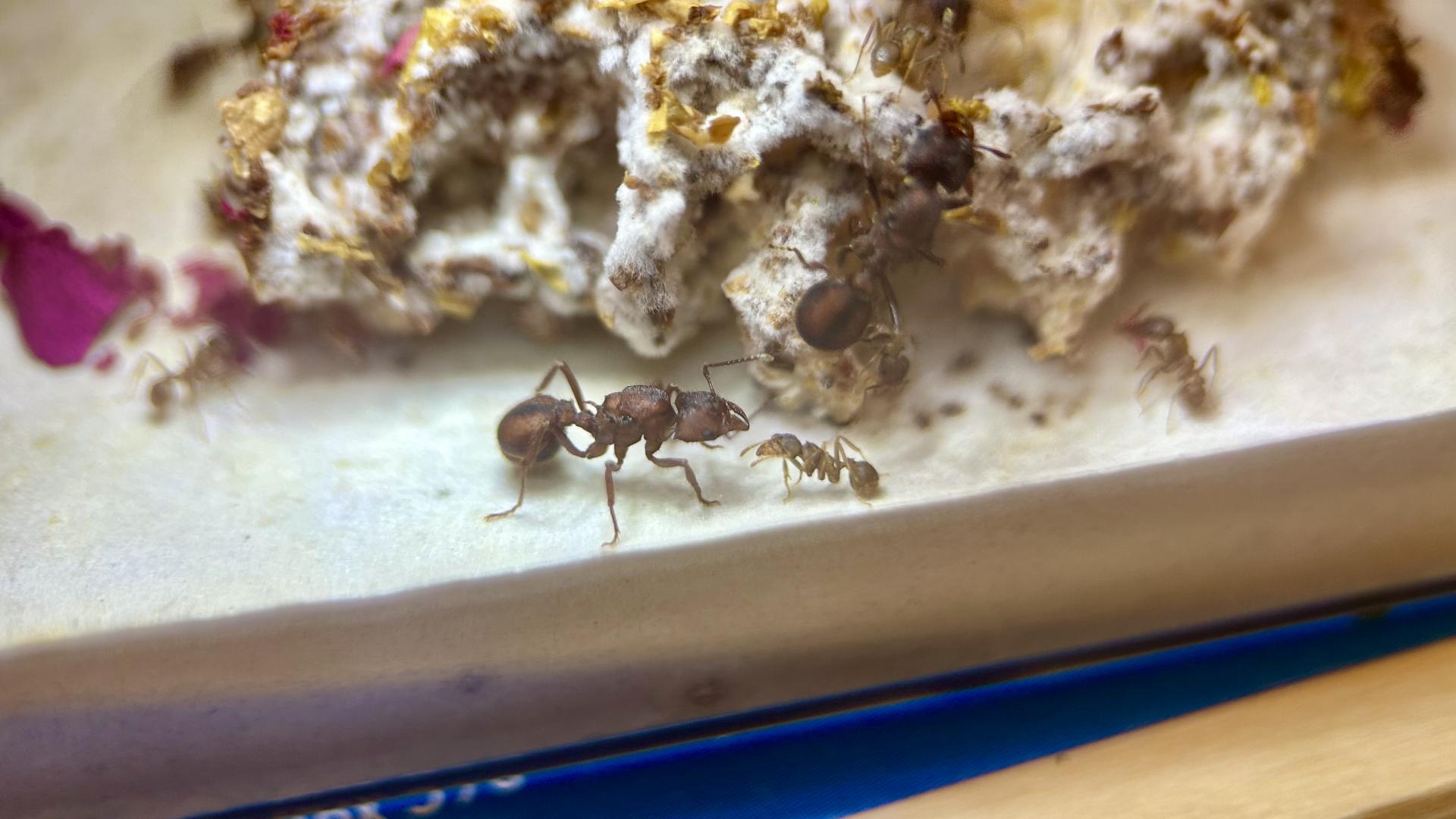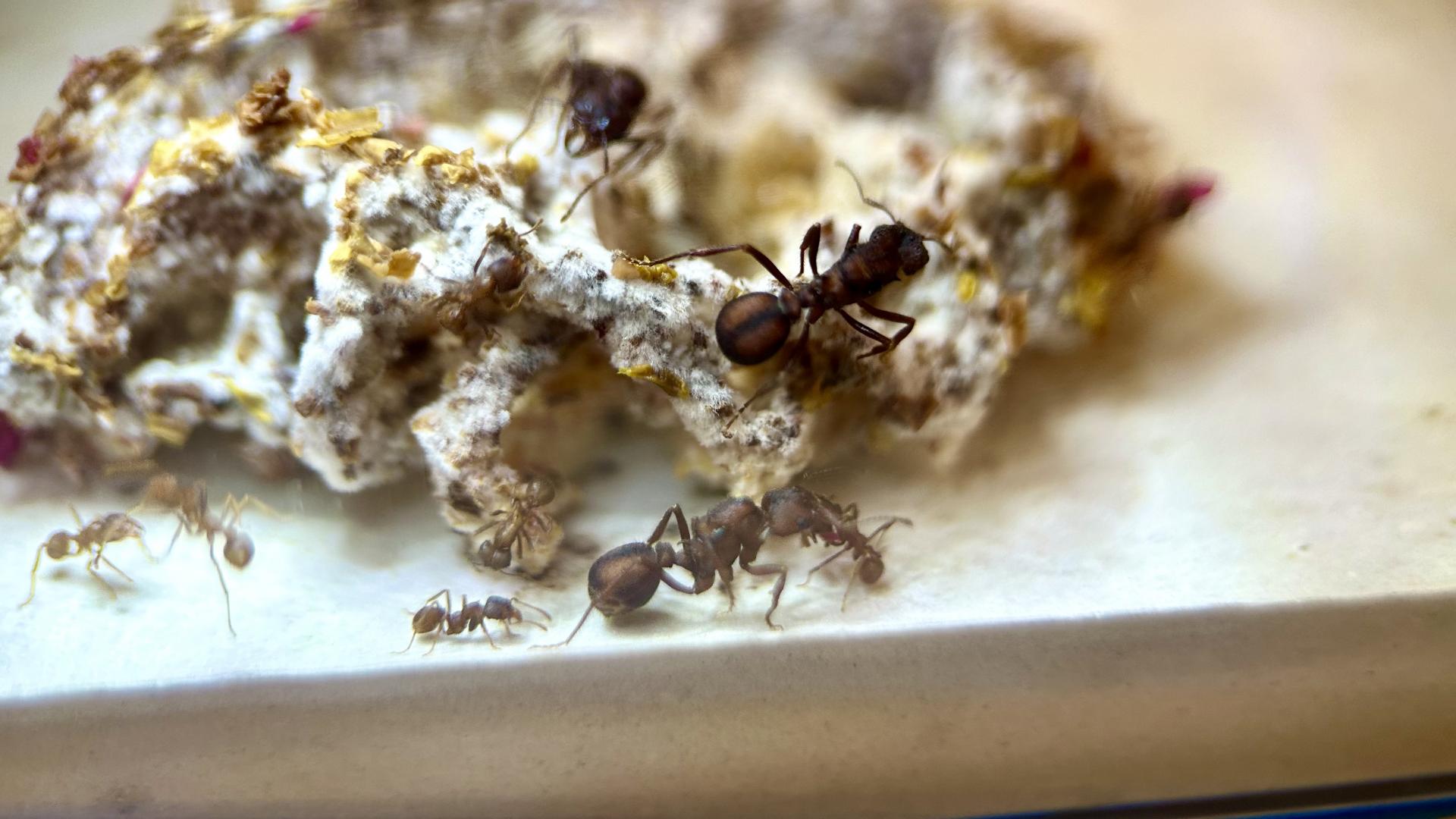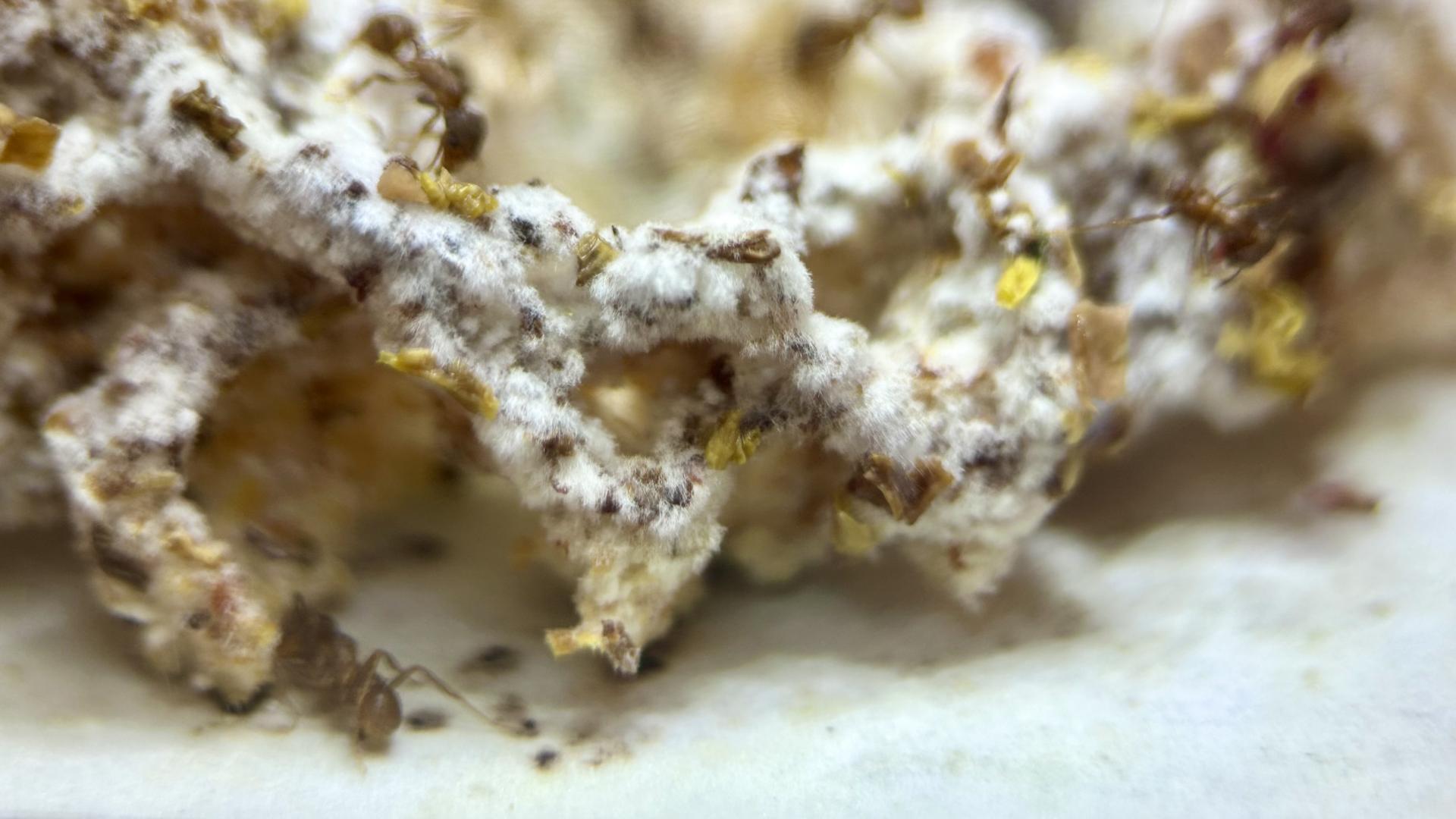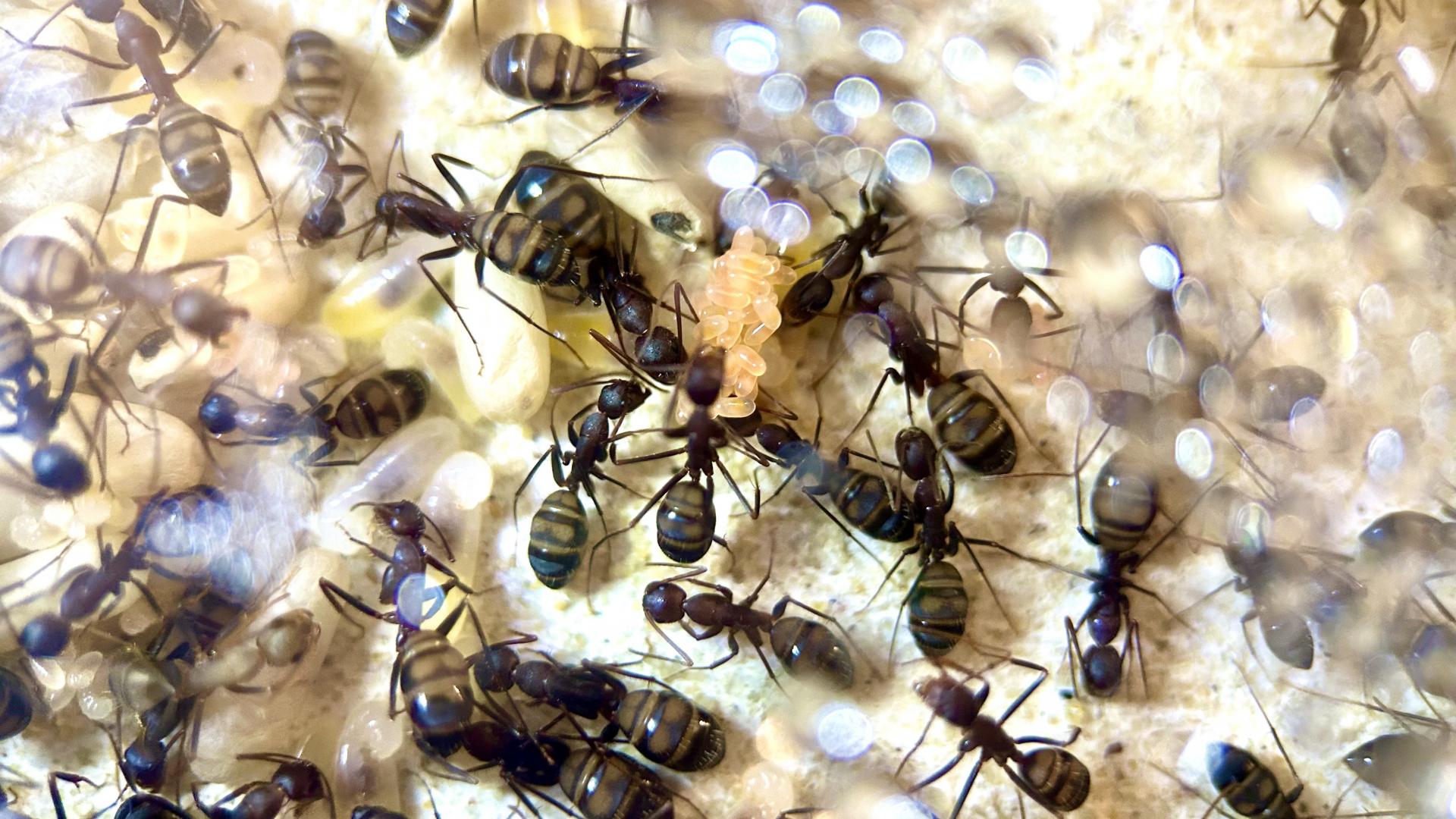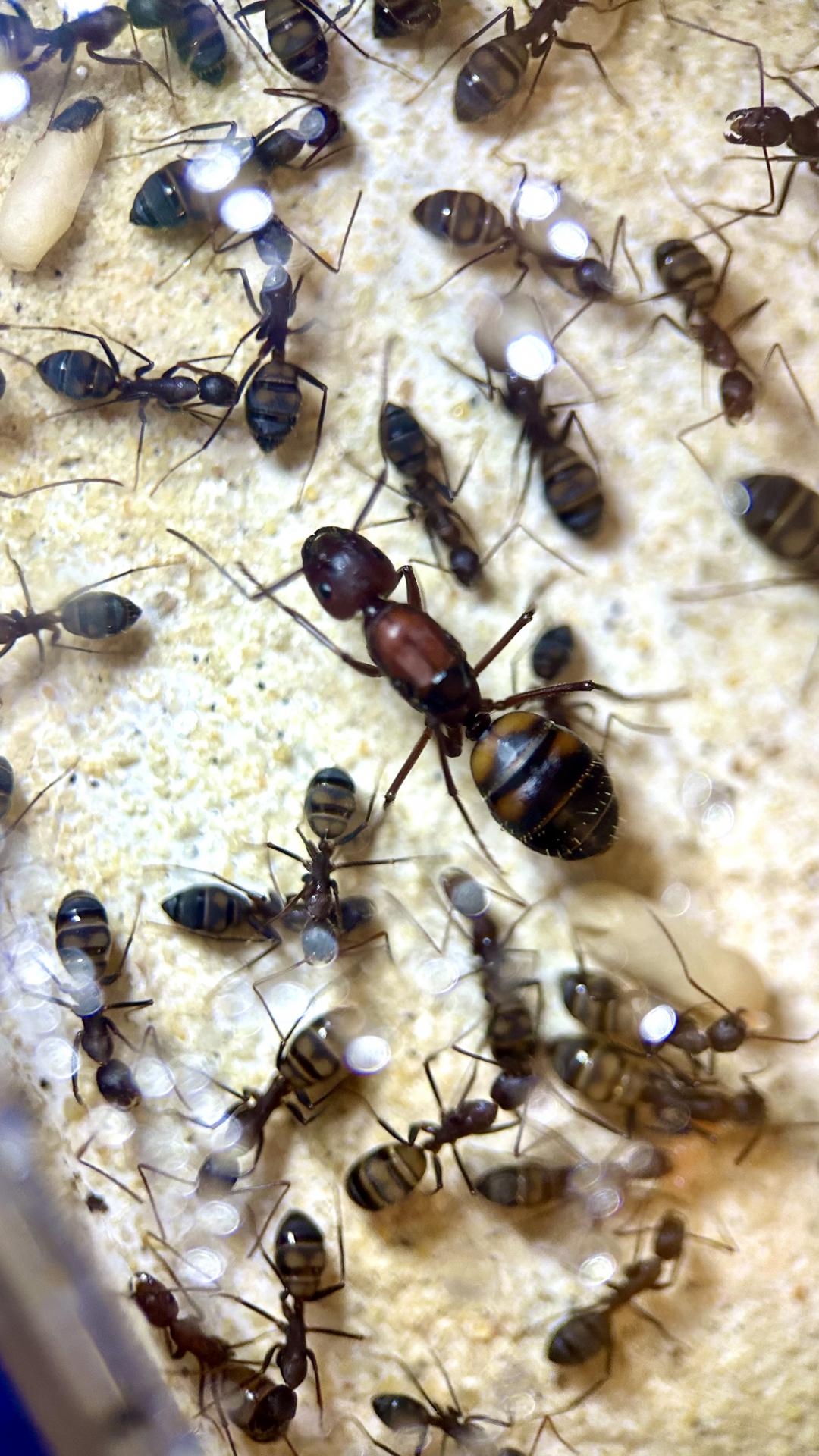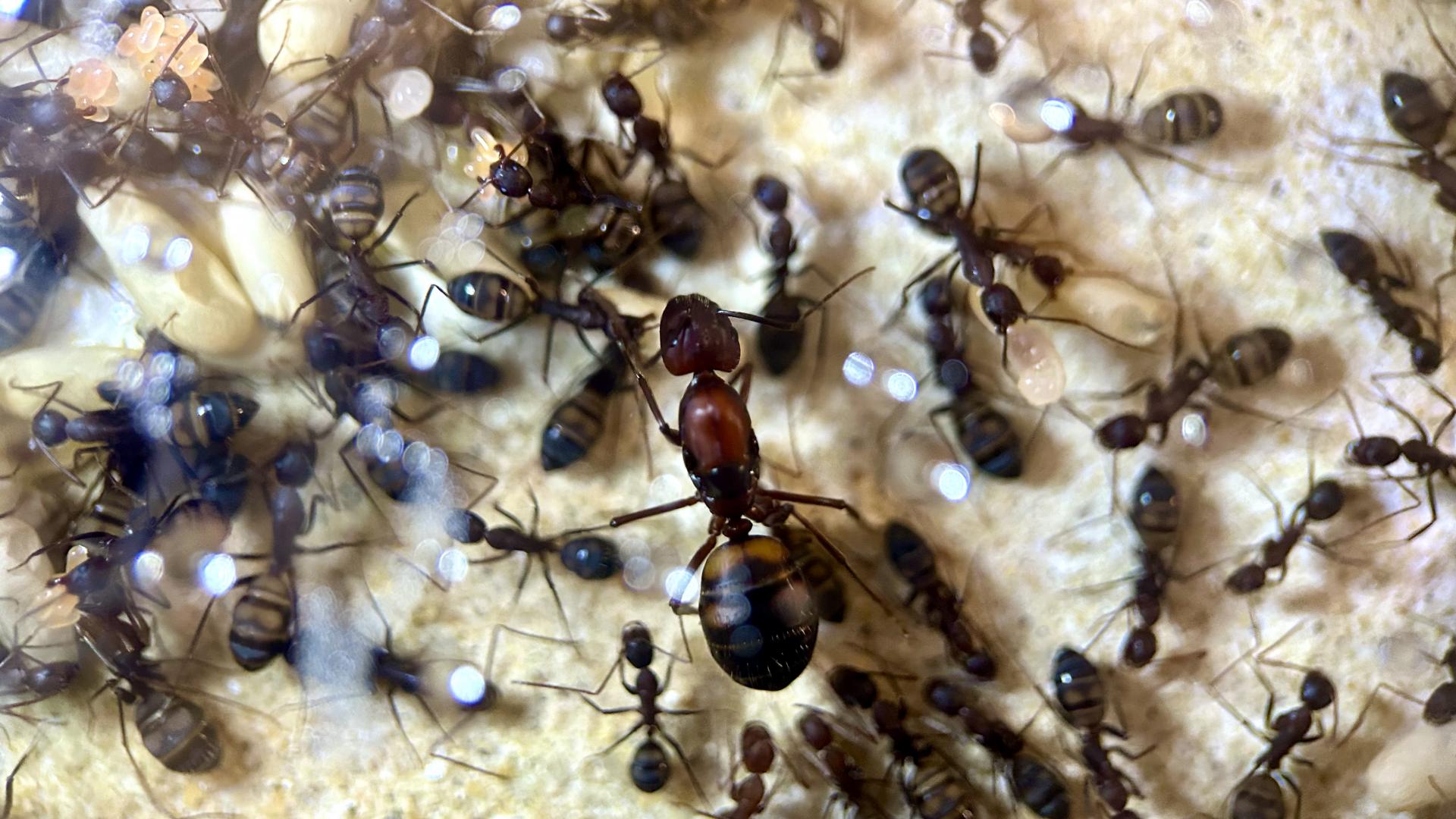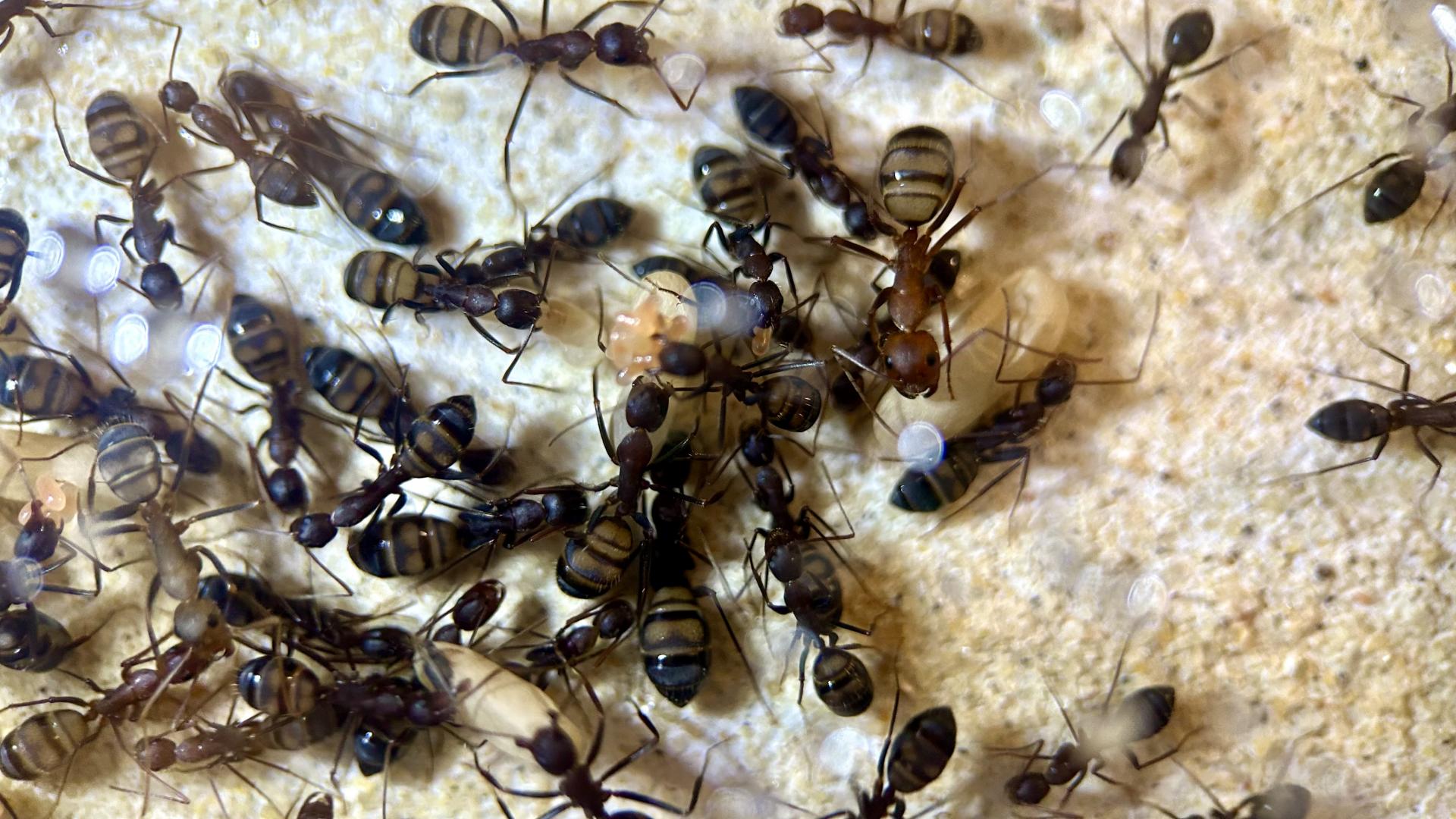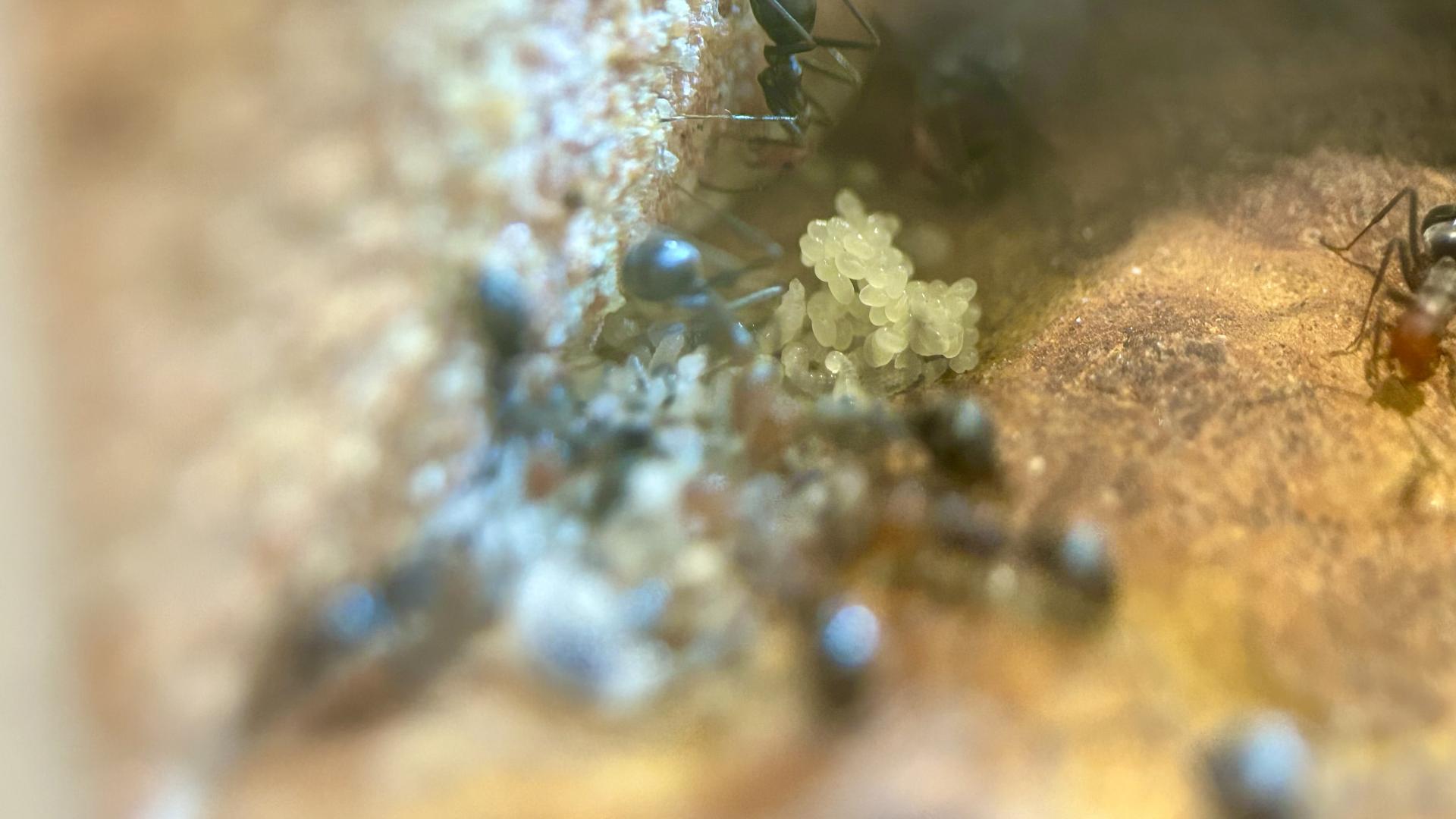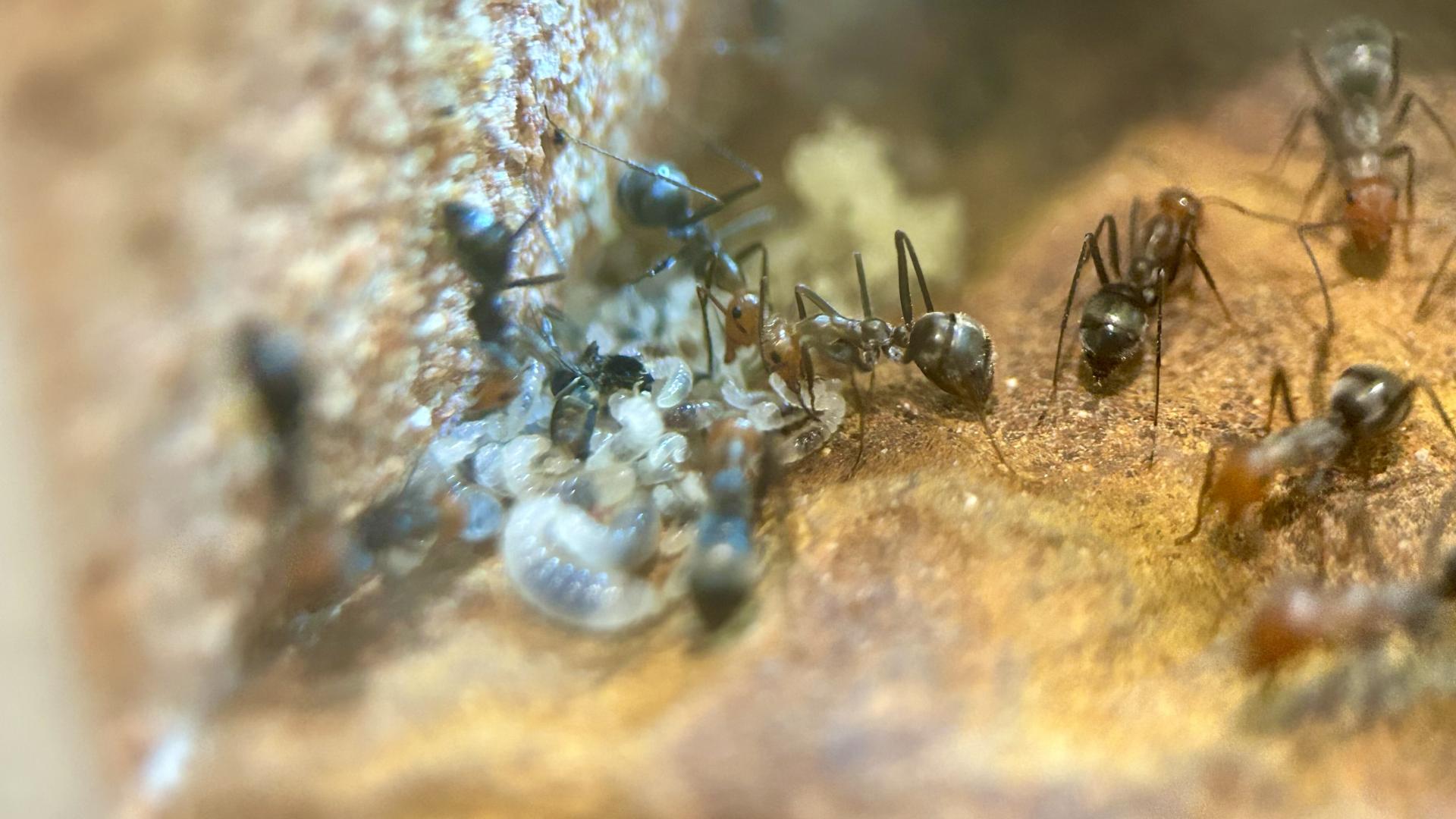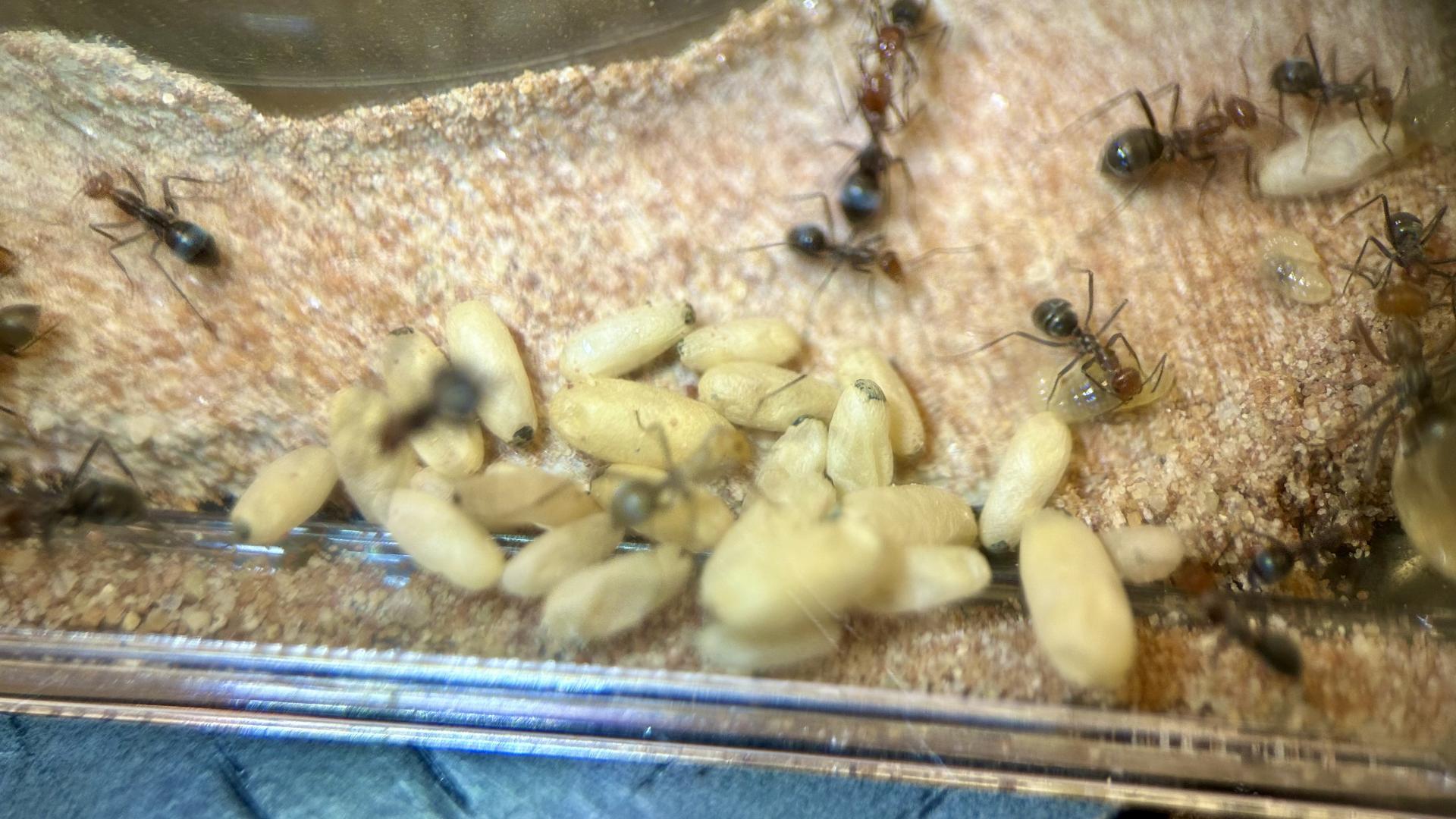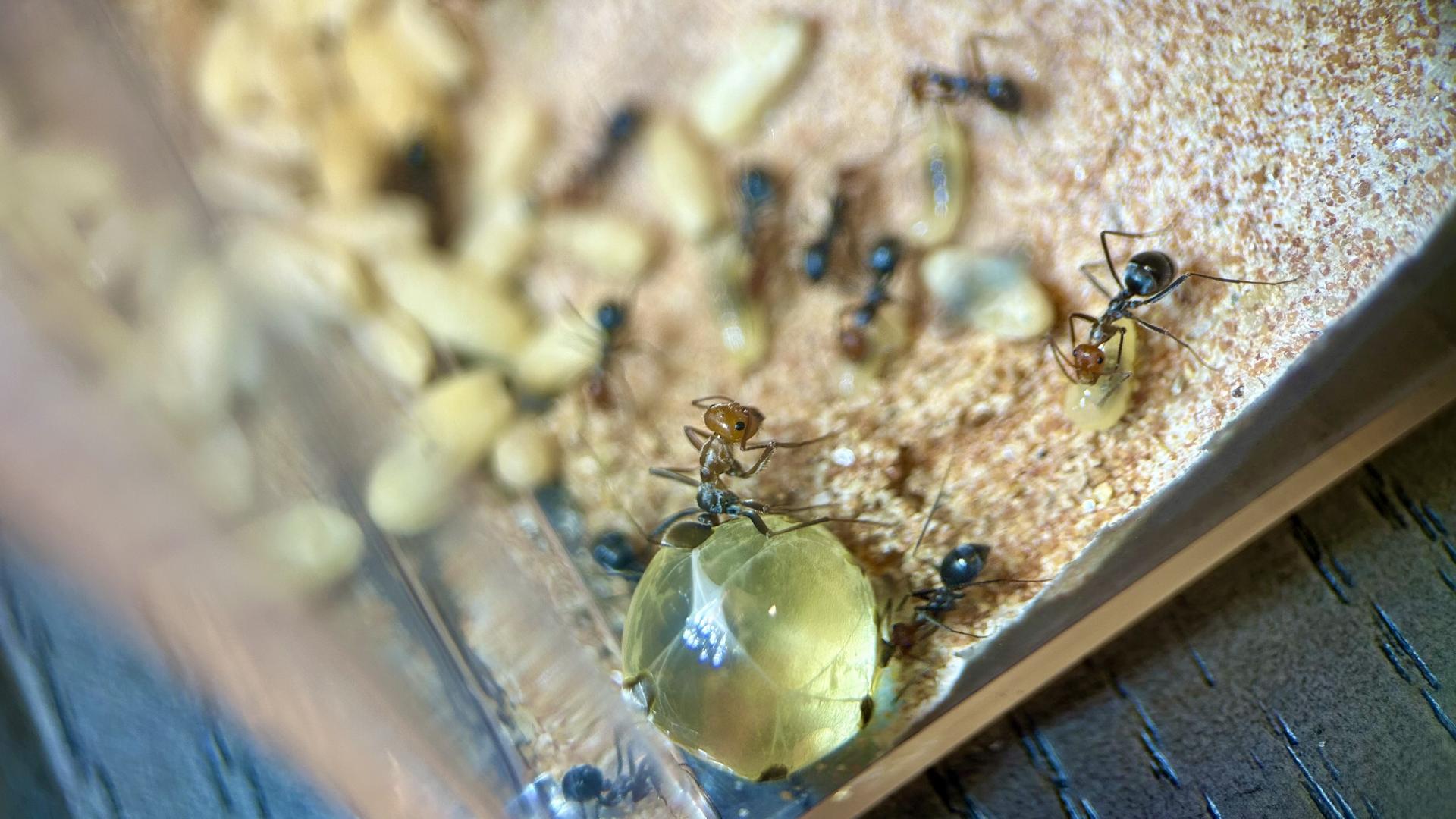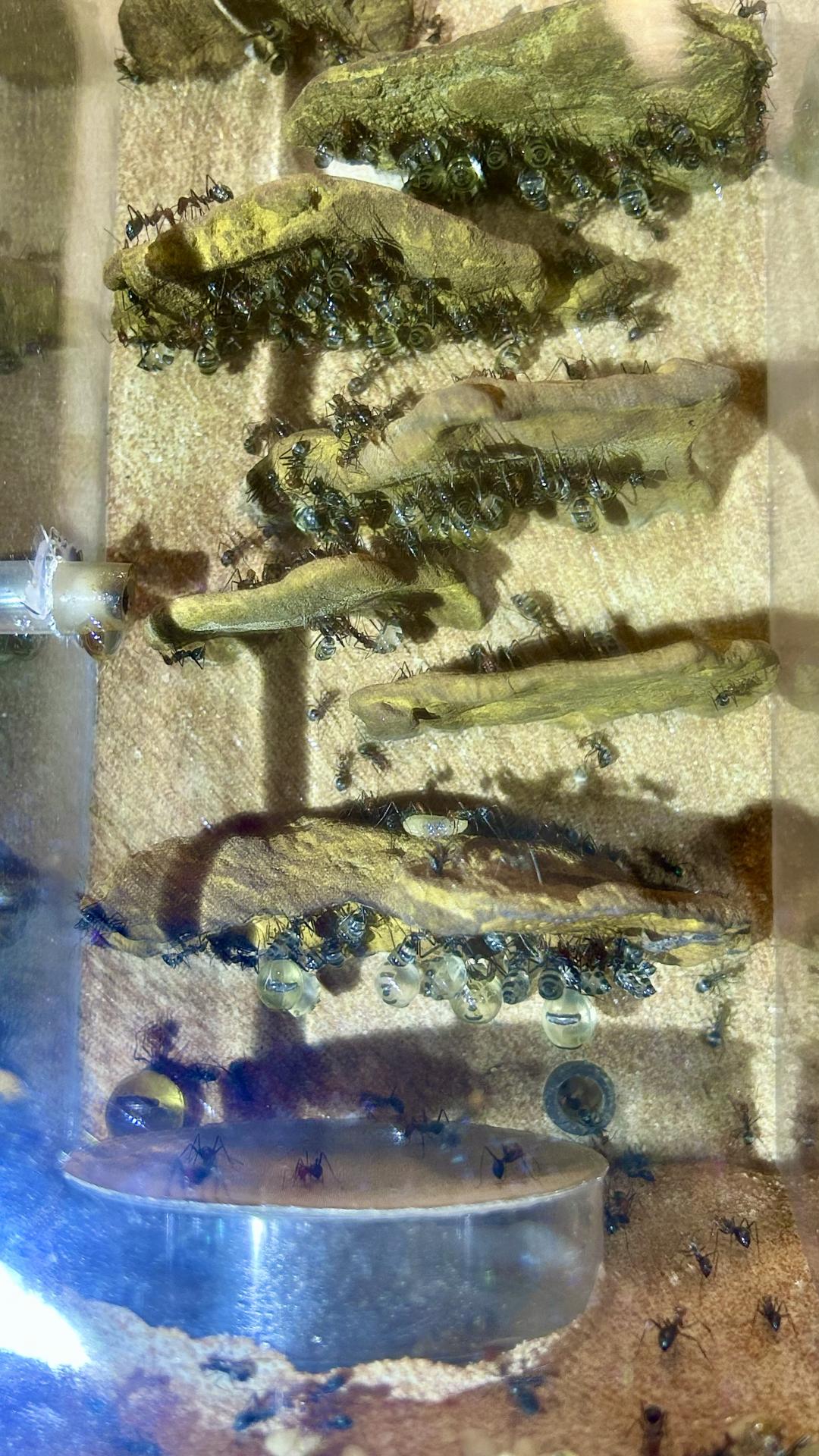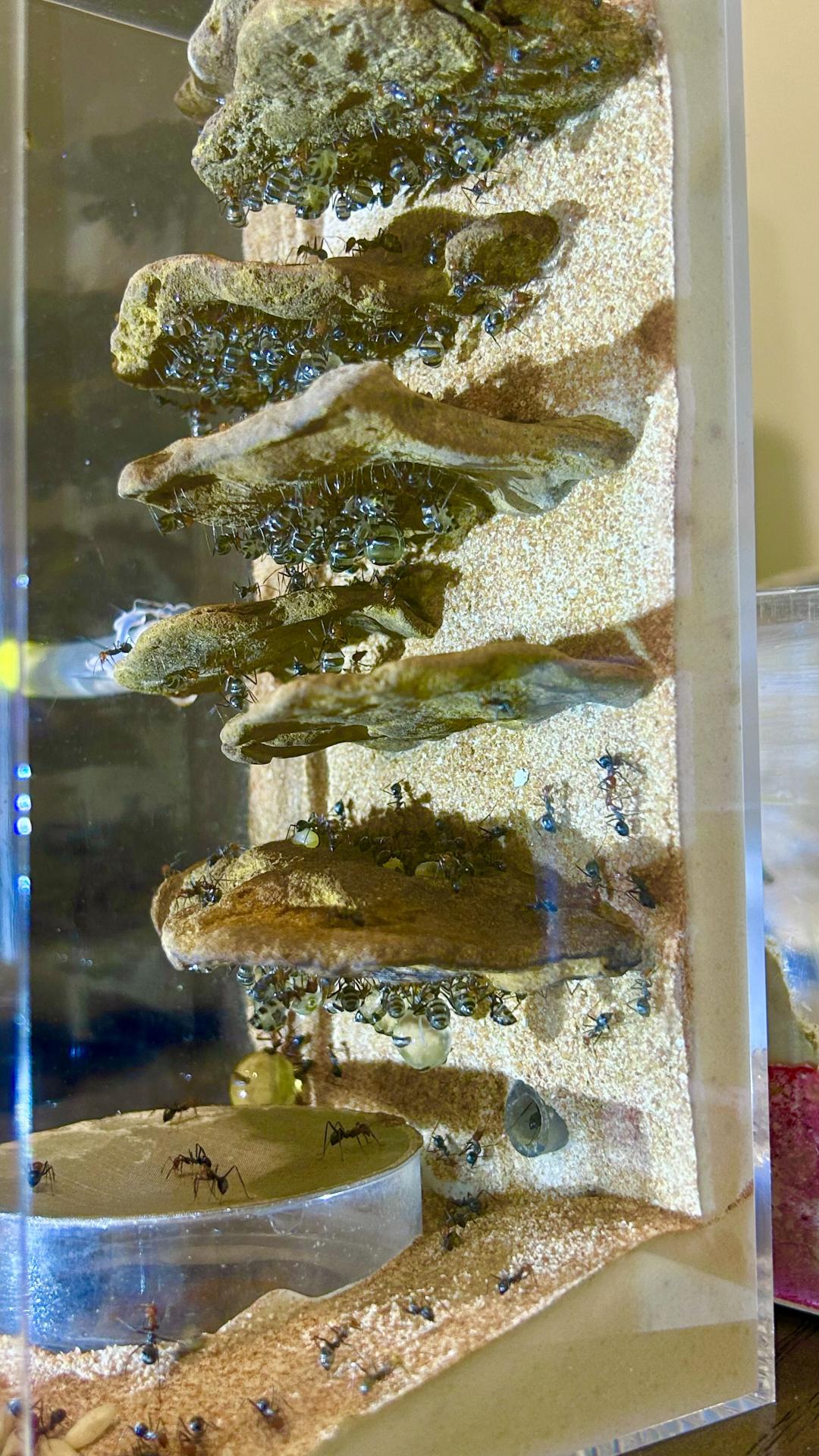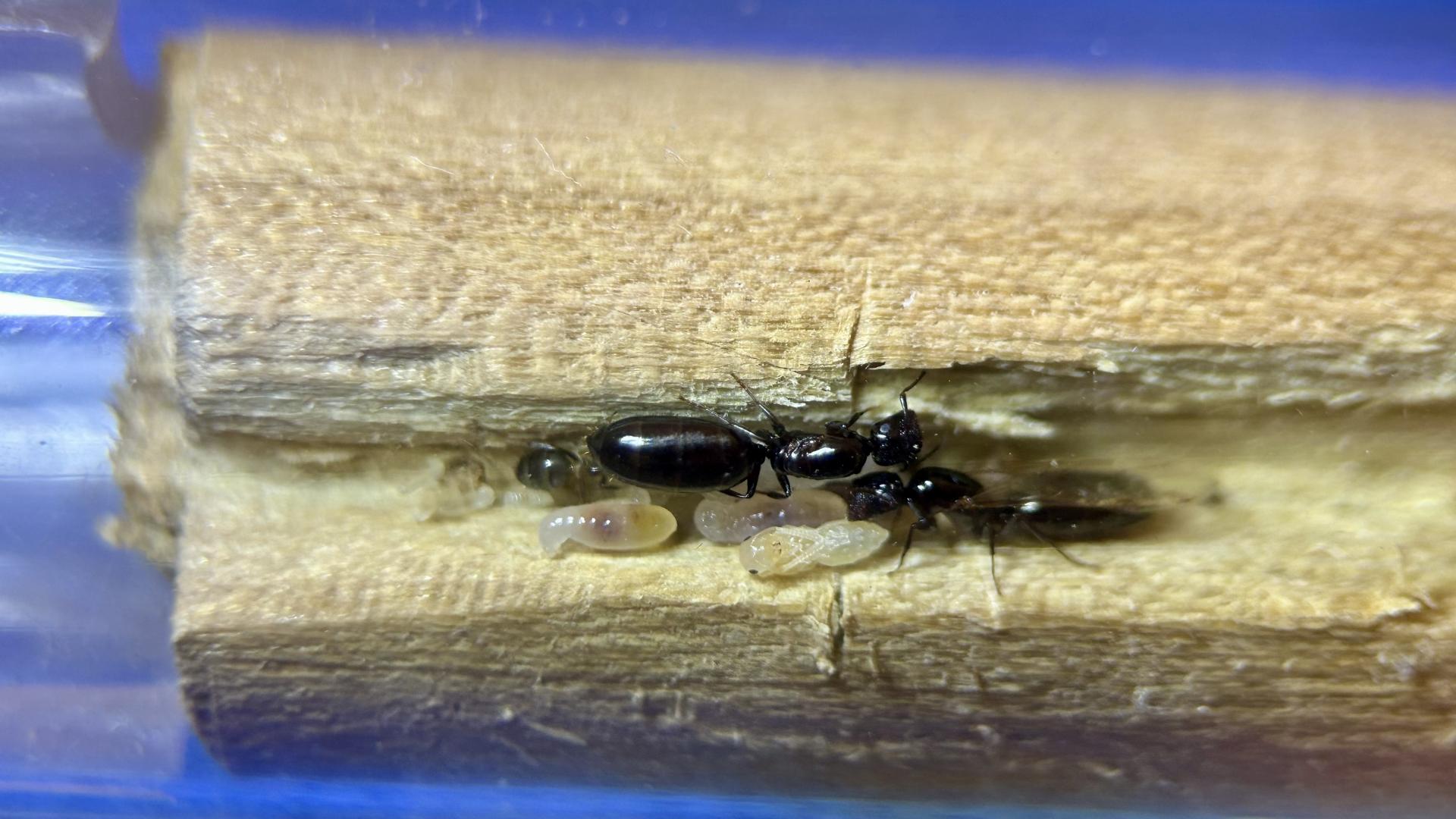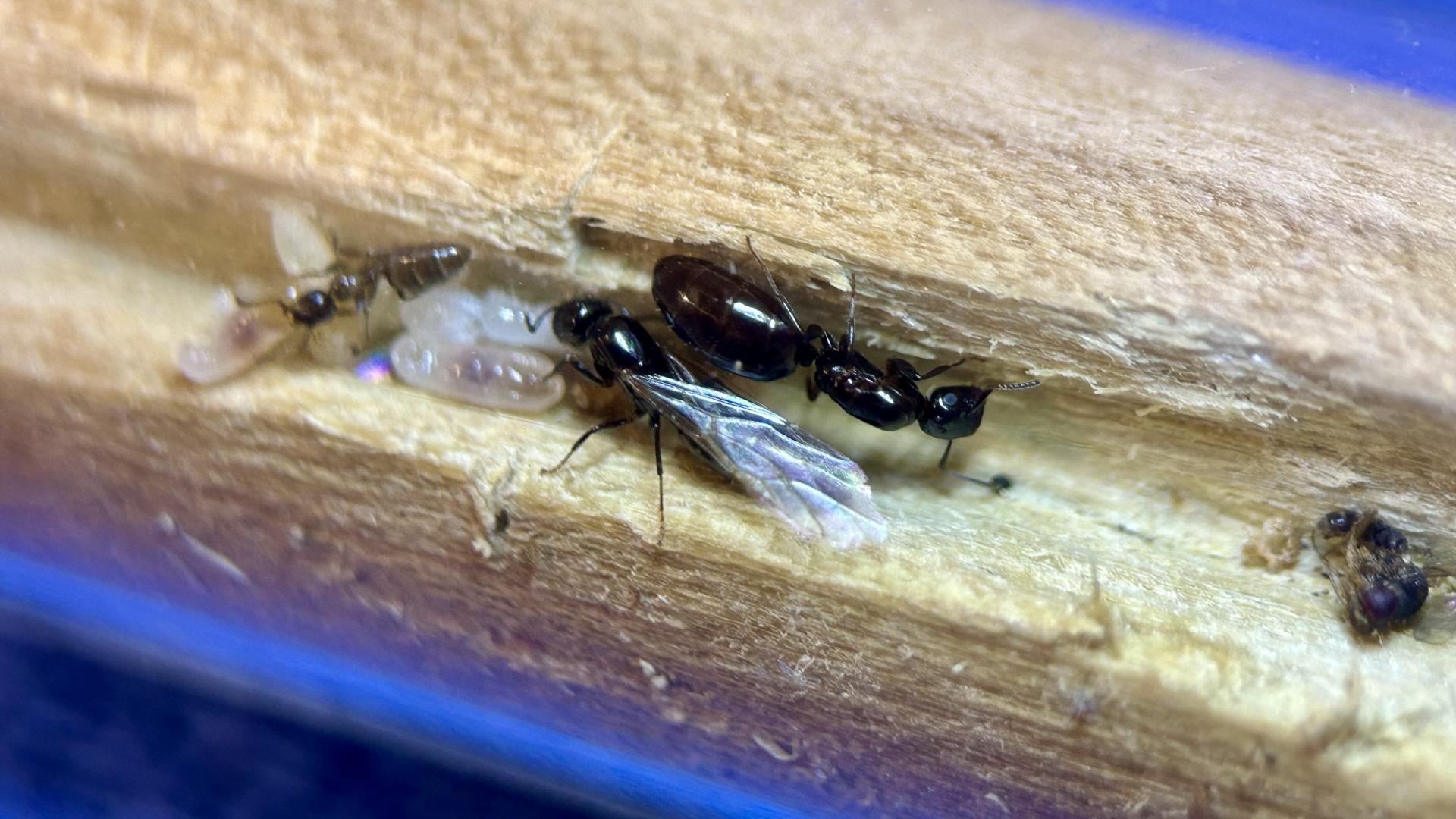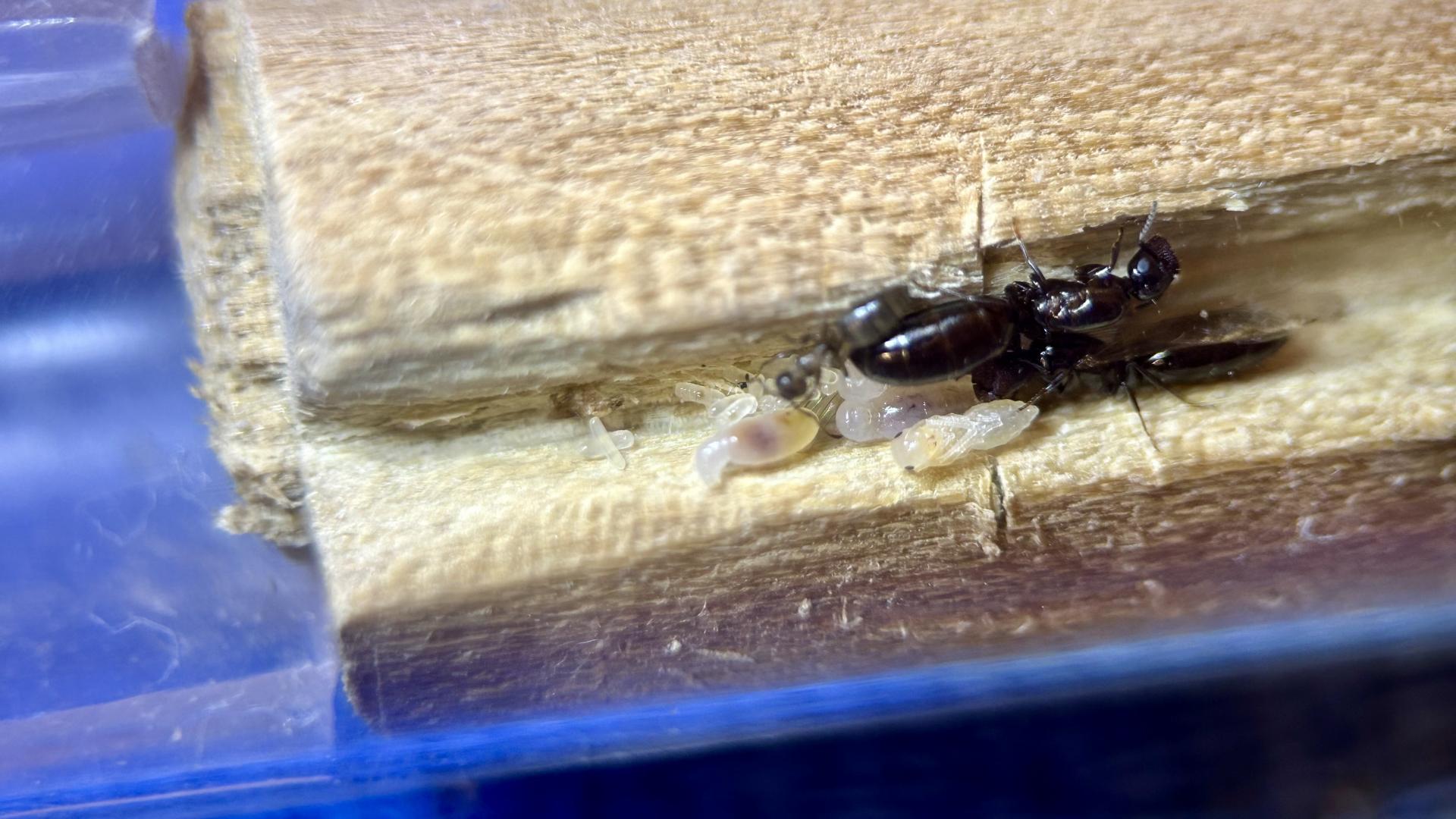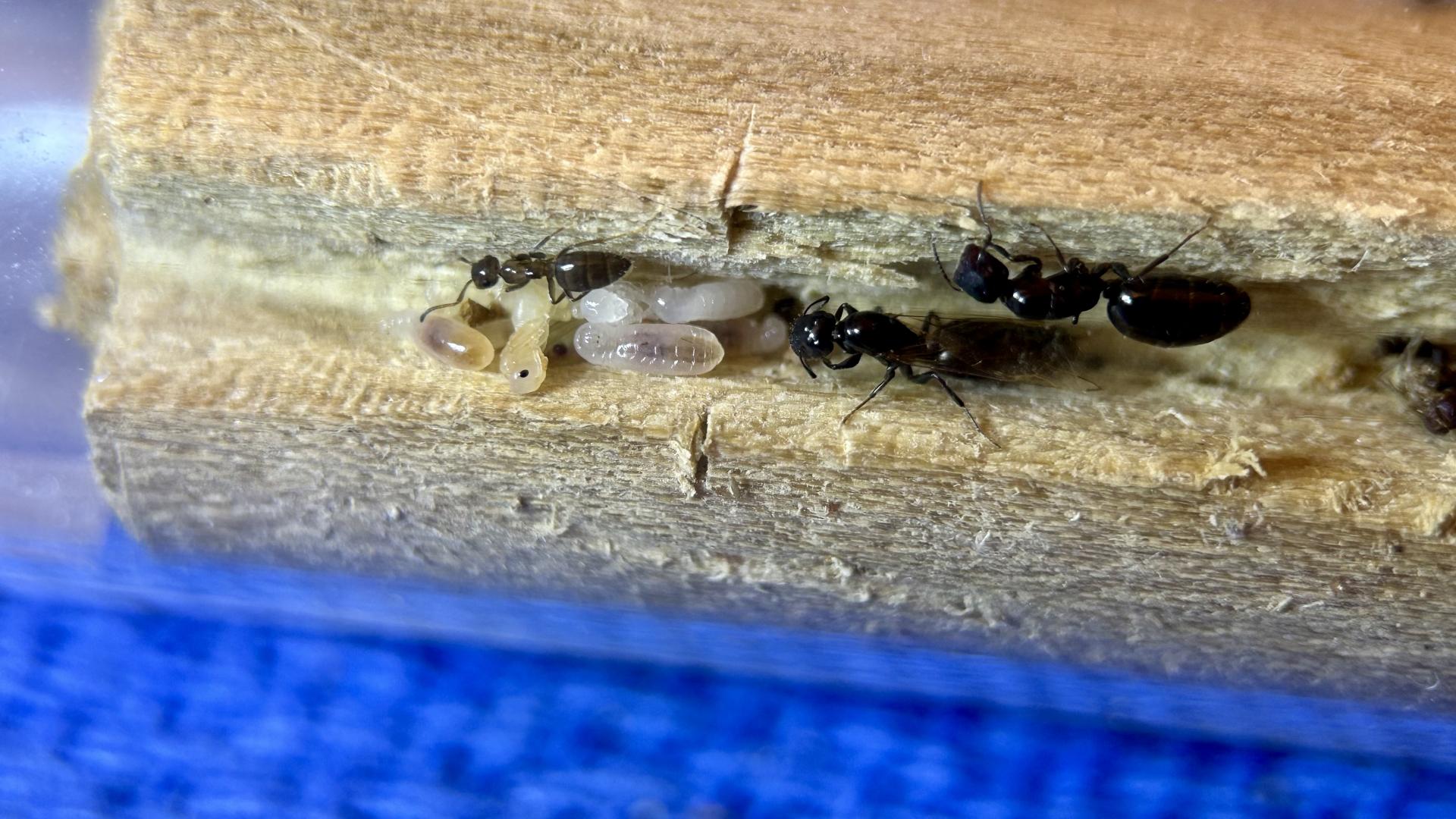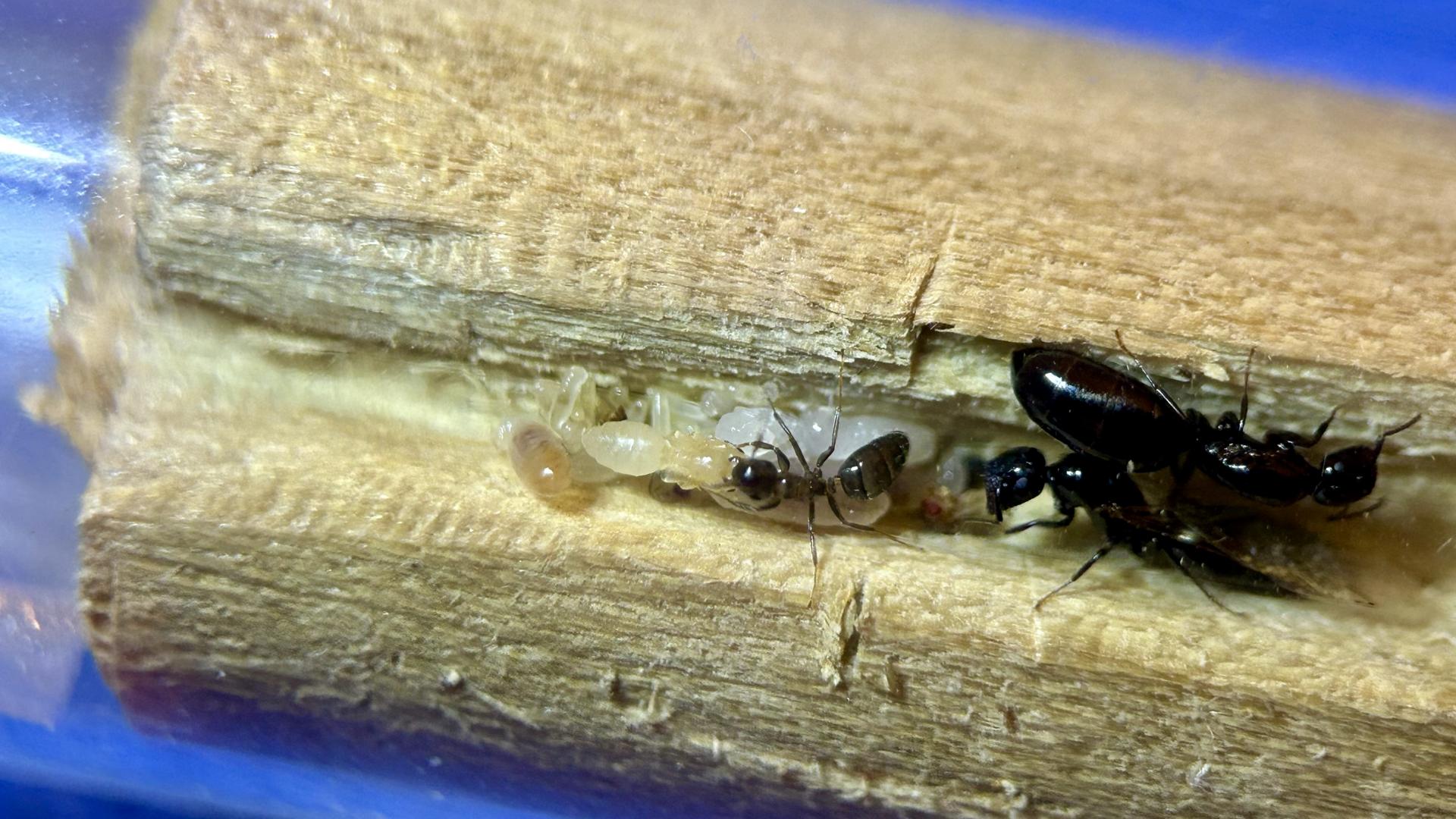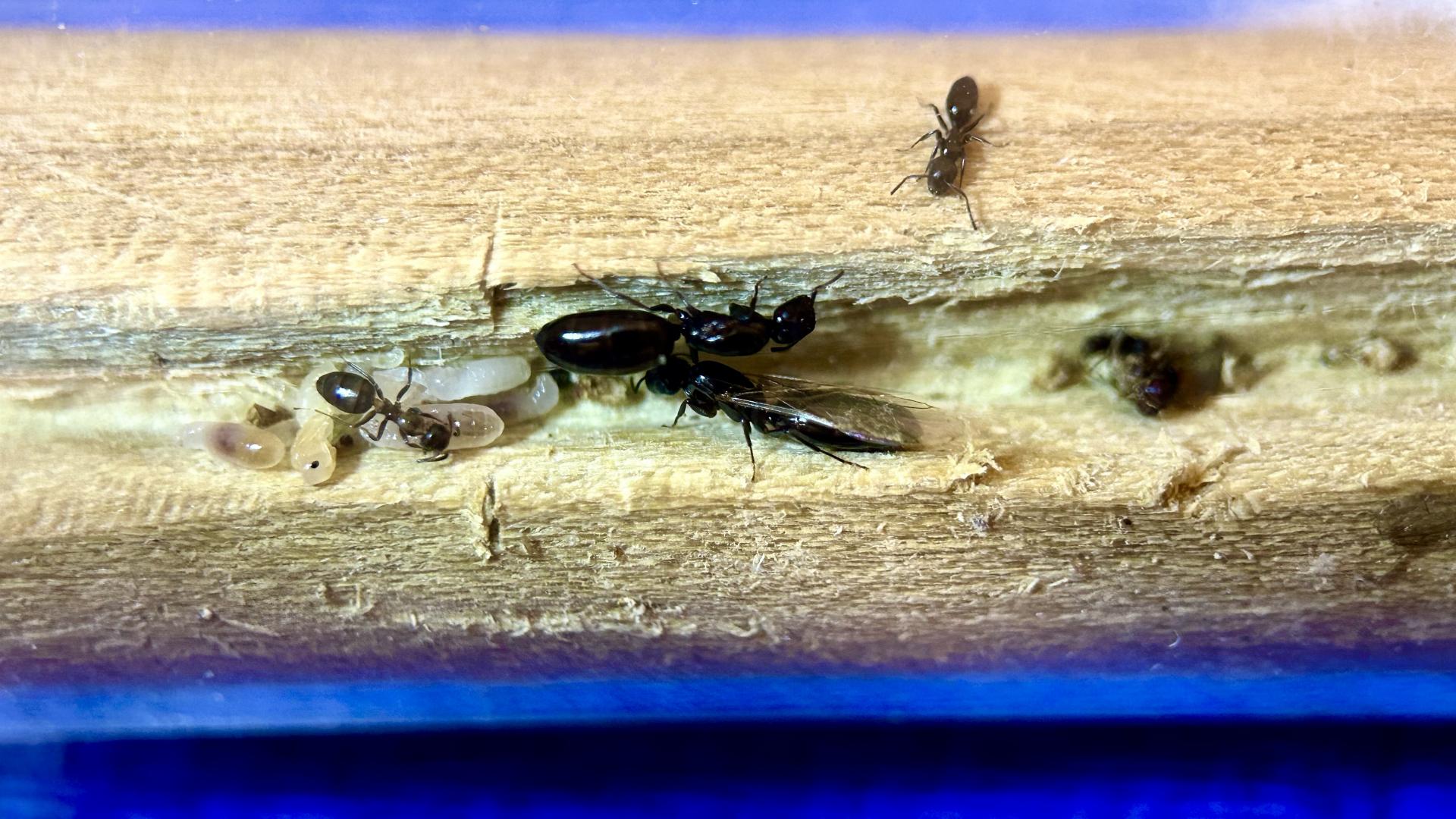- Formiculture.com
- Forums
- Gallery
- Members
- Member Map
- Chat

Kiedeerk's Epic multi-species Ant Keeping Journal
Started By
kiedeerk
, Jul 8 2023 7:15 PM
kiedeerk journal multi-species ant keeping epic
288 replies to this topic
#201
 Offline
-
Posted October 18 2024 - 5:07 PM
Offline
-
Posted October 18 2024 - 5:07 PM
Acromyrmex vesicolor got their first workers today. They laid their first eggs on 09/07-08 and first workers eclosed 10/18. Many more workers are close to eclosing so expect their population to jump in the next week or two. One colony (3 queens) is doing much better than the other two. They all have pupae though so just to show how queens differ greatly in terms of how many workers they rear in their first batch of nanitics.
- Karma, ANTdrew, RushmoreAnts and 3 others like this
#202
 Offline
-
Posted October 19 2024 - 1:56 AM
Offline
-
Posted October 19 2024 - 1:56 AM
Awesome!
"The ants are a people not strong, yet they prepare their meat in the summer." Prov. 30:25
Keep ordinary ants in extraordinary ways.
Keep ordinary ants in extraordinary ways.
#203
 Offline
-
Posted October 23 2024 - 12:33 PM
Offline
-
Posted October 23 2024 - 12:33 PM
Camponotus socius doing great. They have well over 100 workers now. They eclosed couple media workers and one major worker. As mentioned earlier, compared to native species like pennsylvanicus they produced media/majors much later. Hopefully we will see more majors in the near future. I was also told that as the colony matures, the color of the workers will change to more reddish color for their thorax similar to the queen.
- RushmoreAnts and AntsGodzilla like this
#204
 Offline
-
Posted October 23 2024 - 12:48 PM
Offline
-
Posted October 23 2024 - 12:48 PM
So pretty! Man I wish that I could have the time and money to do this but I don't. Anyways nice journal been enjoying this!
Edited by Yusteponant, October 23 2024 - 12:49 PM.
#205
 Offline
-
Posted October 23 2024 - 12:51 PM
Offline
-
Posted October 23 2024 - 12:51 PM
Camponotus socius doing great. They have well over 100 workers now. They eclosed couple media workers and one major worker. As mentioned earlier, compared to native species like pennsylvanicus they produced media/majors much later. Hopefully we will see more majors in the near future. I was also told that as the colony matures, the color of the workers will change to more reddish color for their thorax similar to the queen.
Sorta looks like Camponotus Novaeboracensis tbh but I guess the color is a little different
#206
 Offline
-
Posted October 23 2024 - 1:29 PM
Offline
-
Posted October 23 2024 - 1:29 PM
Camponotus socius doing great. They have well over 100 workers now. They eclosed couple media workers and one major worker. As mentioned earlier, compared to native species like pennsylvanicus they produced media/majors much later. Hopefully we will see more majors in the near future. I was also told that as the colony matures, the color of the workers will change to more reddish color for their thorax similar to the queen.
Sorta looks like Camponotus Novaeboracensis tbh but I guess the color is a little different
Yes C socius and nicobarensis have similar color patterns. However socius is much bigger and native to southeastern USA.
Edited by kiedeerk, October 23 2024 - 1:30 PM.
- Yusteponant likes this
#207
 Offline
-
Posted October 30 2024 - 5:27 AM
Offline
-
Posted October 30 2024 - 5:27 AM
For native species, it’s time for diapause. Camponotus pennsylvanicus, castaneus, subbarbatus, caryae, and nearcticus. Native trachymyrmex also stopped taking organic matter and the fungus has shrunk drastically. I am worried if I can keep fungus alive throughout diapause. I am hoping the acronyrmex colony will keep the fungus alive so I can transplant it back to the trachy colony once spring comes.
- Karma, UtahAnts, rptraut and 1 other like this
#208
 Offline
-
Posted November 9 2024 - 5:31 AM
Offline
-
Posted November 9 2024 - 5:31 AM
Acromyrmex are doing ok. The largest colony currently has probably 20-30 workers. They are growing the fungus decently. The worry I have is that after the first batch of workers of which the last few are about to eclose, I have not seen any new eggs laid by the queens. They could be hiding them in the fungus but I have not been able to find any. I’m slightly worried whether the fungus which was donated from a native trachymyrmex colony is the right fungus for them. However they were able to raise a good batch of workers off the donated fungus so that’s slightly reassuring. We will just have to wait and see. Maybe they are also just ready for diapause? Even in the southwest where they are native the winter temperature does go down to the 30-40F. I have however kept them at around 75-80 this whole time.
- Karma and AntsGodzilla like this
#209
 Offline
-
Posted November 9 2024 - 7:39 AM
Offline
-
Posted November 9 2024 - 7:39 AM
Never diapause any fungus growers, getting to cold will kill the fungus. Keep doing what you are doing.
It's super cool watching this colony grow!
I keep: pogonomyrmex rugosus | myrmecocystus depilis | monomorium ergatogyna | Camponotus CA-02 | Pheidole Bicarinata
And many Carnivorous plants such as: Dionea (fly trap), Sarracenia (American Pitcher plant), Nepenthese (Tropical Pitcher plant), Drosera, (sundew) and Pinguicula (Butterwort) (show off your plants here)
Go to the ant, you sluggard; consider its ways and be wise! It has no commander, no overseer or ruler, yet it stores it's provisions in summer and gathers its food at harvest. Proverbs 6: 6-8
#210
 Offline
-
Posted November 9 2024 - 7:46 AM
Offline
-
Posted November 9 2024 - 7:46 AM
Never diapause any fungus growers, getting to cold will kill the fungus. Keep doing what you are doing.
It's super cool watching this colony grow!
Native trachymyrmex are definitely in diapause mode. They stopped feeding the fungus and it shrunk to 1/10 of its normal size already and keep on shrinking daily
#211
 Offline
-
Posted November 9 2024 - 8:12 AM
Offline
-
Posted November 9 2024 - 8:12 AM
Oh I meant acromyrmex/atta. Sorry for the miscommunication.
Edited by AntsGodzilla, November 9 2024 - 8:16 AM.
I keep: pogonomyrmex rugosus | myrmecocystus depilis | monomorium ergatogyna | Camponotus CA-02 | Pheidole Bicarinata
And many Carnivorous plants such as: Dionea (fly trap), Sarracenia (American Pitcher plant), Nepenthese (Tropical Pitcher plant), Drosera, (sundew) and Pinguicula (Butterwort) (show off your plants here)
Go to the ant, you sluggard; consider its ways and be wise! It has no commander, no overseer or ruler, yet it stores it's provisions in summer and gathers its food at harvest. Proverbs 6: 6-8
#212
 Offline
-
Posted November 9 2024 - 4:09 PM
Offline
-
Posted November 9 2024 - 4:09 PM
Camponotus socius doing great. They have 150-200 workers with a couple majors. They have been extremely fast growing for a large Camponotus species much faster than the native Camponotus species. Compared to my pennsylvanicus and castaneus who have between 15-20 workers before diapause.
- Karma, rptraut, Ernteameise and 3 others like this
#213
 Offline
-
Posted November 10 2024 - 5:48 PM
Offline
-
Posted November 10 2024 - 5:48 PM
My “smaller” M placadops are doing good. They are using my diy as intended. Still have a ton of brood. Main problem I always seen with species that require substrate is that over time the workers will move the substrate out of the nest leaving nothing inside. In the wild, the ants will have infinite amount of substrates as they dig the chambers. For most diys we have finite amount of substrate which the ants deplete so you have to keep adding substrate into the nest or else the larva of certain species will fail to pupate.
- Karma, ANTdrew, Demoant and 3 others like this
#214
 Offline
-
Posted November 10 2024 - 9:42 PM
Offline
-
Posted November 10 2024 - 9:42 PM
Colobopsis Papago doing well. Their brood development is a bit slow but they currently have 3 workers and a large brood pile. They should be doubling in size in the coming weeks. They are liking the more natural wood insert with a slit like nesting area. One fun fact, the eggs of colobopsis are very enlongated and thin. You can see some in the pictures below.
- Karma, ANTdrew, Ernteameise and 2 others like this
#215
 Offline
-
Posted November 11 2024 - 6:18 AM
Offline
-
Posted November 11 2024 - 6:18 AM
Colobopsis Papago doing well. Their brood development is a bit slow but they currently have 3 workers and a large brood pile. They should be doubling in size in the coming weeks. They are liking the more natural wood insert with a slit like nesting area. One fun fact, the eggs of colobopsis are very enlongated and thin. You can see some in the pictures below.
WOW, they are very cute, The queens reminds me of how my Crematogaster queen likes to stay near the enterance
Currently keeping:
1x Formica subsericea, 20+ workers + a decently sized brood pile, mostly pupa (40-50)
1x Crematogaster cerasi 2 workers with brood (pls don't die workers)
*As you watch your ants march, remember that every thing begins with a small step and continued by diligence and shared dreams*
-A.T (Me)
#216
 Offline
-
Posted November 11 2024 - 4:33 PM
Offline
-
Posted November 11 2024 - 4:33 PM
WOW, they are very cute, The queens reminds me of how my Crematogaster queen likes to stay near the enterance
Colobopsis Papago doing well. Their brood development is a bit slow but they currently have 3 workers and a large brood pile. They should be doubling in size in the coming weeks. They are liking the more natural wood insert with a slit like nesting area. One fun fact, the eggs of colobopsis are very enlongated and thin. You can see some in the pictures below.
Actually that’s the back end of the tube towards the cotton/water.
#217
 Offline
-
Posted November 12 2024 - 12:07 PM
Offline
-
Posted November 12 2024 - 12:07 PM
WOW, they are very cute, The queens reminds me of how my Crematogaster queen likes to stay near the enteranceColobopsis Papago doing well. Their brood development is a bit slow but they currently have 3 workers and a large brood pile. They should be doubling in size in the coming weeks. They are liking the more natural wood insert with a slit like nesting area. One fun fact, the eggs of colobopsis are very enlongated and thin. You can see some in the pictures below.
Actually that’s the back end of the tube towards the cotton/water.
Oh ok, but they are still very cute and remind me of my Crematogaster colony. Don't these ants have majors from what I remember
Also, where are you located, somewhere in the USA?
Currently keeping:
1x Formica subsericea, 20+ workers + a decently sized brood pile, mostly pupa (40-50)
1x Crematogaster cerasi 2 workers with brood (pls don't die workers)
*As you watch your ants march, remember that every thing begins with a small step and continued by diligence and shared dreams*
-A.T (Me)
#218
 Offline
-
Posted November 12 2024 - 12:55 PM
Offline
-
Posted November 12 2024 - 12:55 PM
Oh ok, but they are still very cute and remind me of my Crematogaster colony. Don't these ants have majors from what I remember
Also, where are you located, somewhere in the USA?
He would have to be somewhere in the southwest, as that is where acromyrmex and myrmecocystus are mainly located.
I keep: pogonomyrmex rugosus | myrmecocystus depilis | monomorium ergatogyna | Camponotus CA-02 | Pheidole Bicarinata
And many Carnivorous plants such as: Dionea (fly trap), Sarracenia (American Pitcher plant), Nepenthese (Tropical Pitcher plant), Drosera, (sundew) and Pinguicula (Butterwort) (show off your plants here)
Go to the ant, you sluggard; consider its ways and be wise! It has no commander, no overseer or ruler, yet it stores it's provisions in summer and gathers its food at harvest. Proverbs 6: 6-8
#219
 Offline
-
Posted November 12 2024 - 4:05 PM
Offline
-
Posted November 12 2024 - 4:05 PM
not too true as he said he was located around virginia if i remember. And he likely has permits for these ants
Currently keeping: 2 C.vicinus colonies.2 C.sansabeanus. 1 C.leavissimus. 2 C.Ca02. 1 V.pergandei. 4 T.immigrans.1 F.pacifica. 1 C.hyatti
1 M.ergatognya
Trying to get my hands on :C.modoc,A.vercicolor, and Any Honeypots
#220
 Offline
-
Posted November 12 2024 - 4:15 PM
Offline
-
Posted November 12 2024 - 4:15 PM
How can you get permits for a species not native to that state?
I keep: pogonomyrmex rugosus | myrmecocystus depilis | monomorium ergatogyna | Camponotus CA-02 | Pheidole Bicarinata
And many Carnivorous plants such as: Dionea (fly trap), Sarracenia (American Pitcher plant), Nepenthese (Tropical Pitcher plant), Drosera, (sundew) and Pinguicula (Butterwort) (show off your plants here)
Go to the ant, you sluggard; consider its ways and be wise! It has no commander, no overseer or ruler, yet it stores it's provisions in summer and gathers its food at harvest. Proverbs 6: 6-8
Also tagged with one or more of these keywords: kiedeerk, journal, multi-species, ant keeping, epic
0 user(s) are reading this topic
0 members, 0 guests, 0 anonymous users



